Contents
- 1. Users Manual 1.1
- 2. Users Manual 1.2
- 3. Users Manual 2
Users Manual 1.2
148 Chapter 7 Exchanging Messages
Synchronizing email messages
Synchronizing email messages ensures that new email messages
are downloaded to the phone Inbox folder, email messages in the
Outbox folder are sent, and email messages deleted from the server
are removed from your phone. The manner in which you sync email
messages depends on the type of email account you have.
To automatically sync an Outlook email account
1. Connect your phone to your computer through USB or
Bluetooth.
Otherwise, connect through a Wi-Fi or data connection if you are
synchronizing Outlook email with the Exchange Server. For more
information, see Chapter 8.
2. Synchronization automatically begins, and your phone sends and
receives Outlook email.
To manually sync your Outlook or Internet email account
1. Press START and then tap E-mail, or from the Home screen, slide
to the Mail tab.
2. Select the email account you want to sync.
3. Tap Menu > Send/Receive.
Filtering your email inbox
When your inbox is full of email, you can filter the inbox to display only
the email messages that contain a particular sender or subject that
you are looking for.
1. On the Home screen, slide to the Mail tab.
2. Tap an email account and then tap Inbox.
Chapter 7 Exchanging Messages 149
3. Enter the sender name or subject you want to look for. As you
type characters, the message list narrows down to the sequence
of characters you have entered.
For example, entering “je” narrows down the list to only the email
messages that contain sender names and words in the subject
that start with “je.”
Customizing email settings
You can make changes to your email account settings or customize
download and email size settings.
To change basic email settings
1. On the Home screen, slide to the Mail tab and then tap Menu >
Account Settings.
2. Tap the email account that you want to modify and make
the necessary changes. You can change your email address,
password, email provider settings, and more, if you mistyped
or chose any wrong options when you were setting up your
account.
To change the sync schedule for an Internet email account
1. On the Home screen, slide to the Settings tab and then tap Data
services.
2. Scroll down the screen to see your email accounts.
3. Tap the email account whose sync schedule you want to change.
4. Make sure the Send/Receive E-mail automatically option is
selected, and then tap the box under this option to choose a time
interval for synchronizing email.
5. Tap Done.
150 Chapter 7 Exchanging Messages
To customize advanced settings for an Internet email account
1. Press START and then tap E-mail.
2. Tap Menu > Options and then tap the email account that you
want to modify.
3. On the subsequent screen, you can:
Tap Edit Account Setup to modify settings such as your email
address, password, and more, if you mistyped or chose any
wrong options when you were setting up your email account.
Tap Send/Receive Schedule to select the number of days of
messages to download to your phone.
Tap Download Size Settings to set the message format
to either HTML or plain text, select a download size for
email messages, and choose whether or not to include file
attachments when downloading email (for IMAP4 accounts
only).
To customize settings for Outlook E-mail
1. Disconnect your phone from your computer.
2. Press START and then tap Tools > ActiveSync.
3. Tap Menu > Options, select E-mail, and then tap Settings.
4. On the Sync Options screen, you can set the message format
to HTML or plain text, select the download size limit, and choose
whether to include file attachments when downloading email to
your phone.
5. Close ActiveSync and reconnect your phone to your computer.
•
•
•
Chapter 7 Exchanging Messages 151
To store attachments on the storage card
1. Press START and then tap E-mail.
2. Tap the right or left arrow at the top of the screen repeatedely
until the the Storage tab is selected.
3. Select the When available, use this storage card to store
attachments check box, and then tap OK.

Chapter 8
Working With Company Email and
Meeting Requests
8.1 Synchronizing With the Exchange Server
To keep up-to-date with your work email and meeting schedules and
still have access to the Company Directory while you’re out of the
office, you can connect your phone to the Internet through Wi-Fi or a
data connection and sync with your company’s Exchange Server.
Setting up an Exchange Server connection
To access your Outlook work email and meeting schedules from your
phone, you need to set up an Exchange Server connection on your
phone. You can set this up from the Home screen’s Mail tab. See “Mail”
in Chapter 3 for instructions.
Starting synchronization
Before you start synchronizing with the Exchange Server, make sure
your phone has been set up with a Wi-Fi or data connection to the
Internet so that you can sync over the air. For more information about
connections, see Chapter 9.
After you finish setting up an Exchange Server connection, your
phone automatically starts synchronization.

To manually start synchronization
1. On the Home screen, slide to the Settings tab and then tap Data
services.
2. Tap ActiveSync.
3. Tap Sync now.
8.2 Working With Company Email Messages
Your phone gives you instant access to your company email messages
and lets you manage your messages easier. Direct Push, Fetch Mail,
Remote email search, and email flags are just some of the tools you
can use to manage your email messages.
Some messaging features depend on the Microsoft Exchange Server
version used in your company. Check with your network administrator
for the availability of these features.
Automatic synchronization through Direct Push
Direct Push technology (push email feature) enables you to receive
new email messages on your phone as soon as they arrive in your Inbox
on the Exchange Server. Items such as contacts, calendar and tasks
are also immediately updated onto your phone when these items have
been changed or new entries have been added on the Exchange Server.
To make Direct Push work, you need to have a Wi-Fi or data connection
on your phone. If this is your first time to use Direct Push, you also
need to perform a full synchronization between your phone and the
Exchange Server before Direct Push can be enabled.
The Direct Push feature works for your phone only if your company
is using Microsoft Exchange Server 2003 Service Pack 2 (SP2) with
Exchange ActiveSync or later.

154 Chapter 8 Working With Company Email and Meeting Requests
To turn Direct Push on and off in Comm Manager
After you have set up your Outlook work account, your phone
automatically performs a full synchronization with the Exchange
Server and enables Direct Push. You can turn Direct Push on and off
anytime from the Comm Manager.
1. On the Home screen, slide to the Settings tab and tap Wireless
controls.
2. On the Comm Manager screen, tap the Off/On slider at the right
side of the Microsoft Direct Push item.
When Direct Push is off, you need to manually retrieve your email
messages.
Scheduled synchronization
If you do not want to use Direct Push, you can set a regular schedule
for synchronizing Outlook email and information.
1. On the Home screen, slide to the Settings tab and then tap Data
services.
2. Tap ActiveSync.
3. Tap Peak time and Non-peak time to select different sync
schedules for each.
4. Tap Done.

Chapter 8 Working With Company Email and Meeting Requests 155
Instant download through Fetch Mail
The Fetch Mail feature downloads an entire email immediately without
the need for you to perform a full Send/Receive action. This limits the
download to just the email message that you want and helps save
data cost.
Fetch Mail works for your phone only if your company is using
Microsoft Exchange Server 2007 or later.
1. Press START, tap E-mail > Outlook E-mail and then open an email
message.
2. By default, only the first few words of the message are shown. To
download the whole email, scroll to the end of the message, and
then tap Get the rest of this message.
3. Wait for the remainder of the message body to download.
For information about changing email sync options such as setting
the download size for email, see "Customizing email settings" in
Chapter 7.
When you receive an email that contains a link to a document such
as a PDF or Microsoft Office document located on SharePoint or
an internal file server, you can tap the link to view the document on
your phone. You can view the document only if you have a Microsoft
Outlook account that syncs with Microsoft Exchange Server 2007
or later. Exchange Server must also be set up to allow access to
SharePoint document libraries or internal file servers.
•
•

156 Chapter 8 Working With Company Email and Meeting Requests
Searching for email messages on the Exchange Server
You can access email messages that are not available on your phone
by searching your Microsoft Exchange Server mailbox. The search
results are downloaded and displayed in a Search Results folder.
Your company must be using Microsoft Exchange Server 2007 or later.
1. Press START and then tap E-mail > Outlook E-mail.
2. Tap Menu > Tools > Search Server.
3. In the Look for text box, enter the search keyword.
4. Choose the date range of messages to search from.
5. In the Look in list, specify whether to search in the Inbox, Sent
Items, or All Folders, and then tap Search.
To clear the search results and return to the message list, tap Menu >
Clear Results.
Out-of-office auto-reply
Outlook E-mail allows you to retrieve and change your out-of-office
status. Just like desktop Outlook, Outlook E-mail on your phone
automatically sends an auto-reply message when you’re not available.
1. Press START and then tap E-mail > Outlook E-mail.
2. Tap Menu > Tools > Out of Office.
3. In the I am currently list, select Out of the Office.
4. Enter your auto-reply message, and then tap Done.

Chapter 8 Working With Company Email and Meeting Requests 157
Flagging your messages
Flags serve as a reminder for you to follow-up on important issues
or requests contained in email messages. Flagging messages, which
is a useful feature on desktop Outlook E-mail, can also be done in
Outlook E-mail on your phone. You can flag received email messages
on your phone.
Flags are enabled only if email messages are synchronized with
Microsoft Exchange Server 2007 or later. Flags are disabled or hidden
if email messages are synchronized with earlier versions of Microsoft
Exchange Server.
1. Press START and then tap E-mail > Outlook E-mail.
2. Open a message.
3. Tap Menu > Follow Up and select one of the following options:
Set Flag Mark the message with a red flag to remind yourself to
follow it up.
Complete Flag Mark the message with a check mark to
indicate that the issue or request in the email is already
completed.
Clear Flag Remove the flag to unmark the message.
Email message reminders are displayed on your phone if the messages
are flagged with reminders and synchronized from the Exchange
Server.
•
•
•
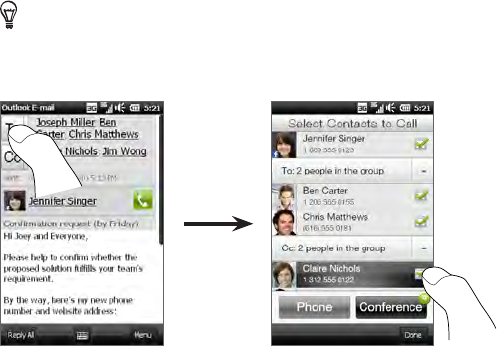
158 Chapter 8 Working With Company Email and Meeting Requests
8.3 Starting a Conference Call from an Email
From an email message that you received in your Outlook work
account, you can directly start a conference call with the sender and
other recipients of the email.
1. On the Home screen, slide to the Mail tab and then select your
Outlook E-mail account.
2. Swipe your finger up or down the screen to browse through
received email. Tap an email message to open it.
3. Tap the To or Cc button.
If you do not see the To and Cc buttons, scroll up the screen.
4. On the Select Contacts to Call screen, select the check boxes
of the sender and recipients who you want to join in your
conference call and then tap Conference.
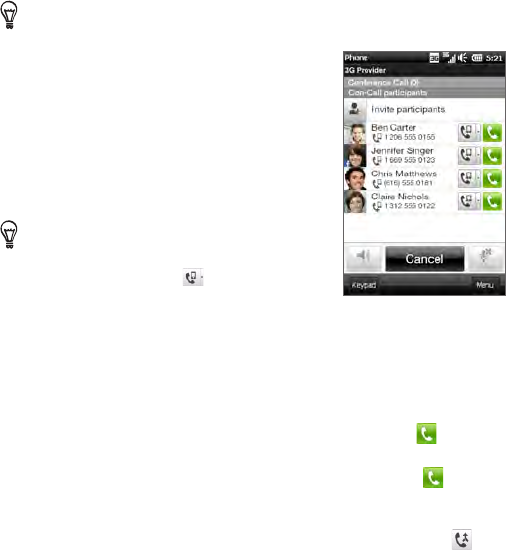
Chapter 8 Working With Company Email and Meeting Requests 159
If you do not see the sender, scroll up the screen first so you
can see and select the sender.
5. The participants list is then displayed
from which you can start the
conference call. You need to call each
participant one at a time and connect
each call to the conference call.
The primary phone number (mobile
number) of each participant will be
dialed.
If you want to choose from
other stored phone numbers
of a participant, tap the Phone
Selection button ( ) that
appears next to the participant’s
name and then select another
number.
To remove a participant before
starting the conference call, tap
Keypad and clear the check box of
that participant.
•
•
6. Dial the first participant by tapping the Talk button ( ) that
appears to the right of this participant.
7. When the first call is connected, tap the Talk button ( ) of
the second participant to dial the second call. The first call is
automatically put on hold.
8. When the second call is connected, tap the Join button ( )
to add it to the conference call. After combining the calls to the
conference, dial the next participant.

160 Chapter 8 Working With Company Email and Meeting Requests
9. Repeat steps 7 and 8 until all participants are added and
connected to the conference call.
While the conference call is in progress, you can still dial and add
more calls. Tap Invite participants ( ) to dial another call. At most,
you can have up to five participants in the conference call.
10. To manage your conference call, such as a putting the conference
call on hold while talking in private with one participant, ending
the conference call, and more, see “During the conference call” in
Chapter 2 for details.
8.4 Meeting Requests
When you schedule and send meeting requests from your phone, you
can invite attendees to your meeting and check their availability.
You can also receive and reply to meeting requests on your phone.
You must have an Outlook E-mail work account that syncs with
Microsoft Exchange Server 2007 or later.
Sending meeting requests
Use the Home screen’s Calendar tab to create and send meeting
requests.
1. On the Home screen, slide to the Calendar tab.
2. If you are scheduling a meeting for the current day, tap Menu >
New Appointment. Otherwise, tap another date on the calendar
and then tap New Appointment.
3. Fill in the details, such as a descriptive name about the meeting,
location, and the start and end time.
4. Under Reminder, choose how soon before the meeting you want
to be notified.

Chapter 8 Working With Company Email and Meeting Requests 161
5. To add required and optional attendees, tap the Add button
( ).
6. Tap the text box that shows the words “E-mail address”. If the
email address of an attendee is stored in your contacts, simply
enter the first few letters of the attendee’s name. A matching list
of contacts will then be displayed, and you can just tap a contact
to add it.
If the email address of an attendee is not stored in your contacts,
enter the full email address and then tap the Enter key to add it.
Repeat this process to add more attendees. Tap Done after
adding all attendees.
If you’re sending the meeting request using your Outlook work
account, you can specify if an attendee is required or optional
only if the Outlook E-mail account on your phone syncs with
Microsoft Exchange Server 2007 or later version. Otherwise, all
attendees are designated as required.
7. Tap Done to send the meeting request.
When attendees accept your meeting request, the meeting is
automatically added to their schedules. When their response is sent
back to you, your calendar is updated as well.
Replying to meeting requests
When you receive a meeting request on your Outlook E-mail work
account, you can reply by accepting or declining the request. The
meeting request also clearly indicates whether or not there are
conflicting or adjacent meetings.
1. When you receive a meeting request email, a notification is
displayed on your phone. Open the email.
2. Tap Accept to reply and accept the meeting request, or tap Menu

162 Chapter 8 Working With Company Email and Meeting Requests
> Decline if you cannot attend the meeting.
Before responding, you can check your availability during the
time of the requested meeting by tapping View your calendar.
If the time of the meeting conflicts with your other appointments,
a “Scheduling Conflict” status appears on top of the email.
•
•
3. Choose whether or not to edit your response email before
sending, and then tap OK.
If you accept the meeting request, it is automatically added as an
appointment in Calendar on your phone.
8.5 Making a Call from a Meeting Request or
Reminder
When you receive a calendar reminder or
meeting request e-mail that contains a
phone number, you can tap the number to
directly place the call.
For example, if you are traveling and need
to join a conference bridge call back in
the home office, rest assured that you can
join the call without delay. Appointment
reminders you receive on your device will
conveniently display the phone number and
PIN, ready for you to dial.

Chapter 8 Working With Company Email and Meeting Requests 163
8.6 Finding Contacts in the Company Directory
You can access information of your work contacts, such as their email
addresses, from your company’s Company Directory on your phone.
By having over-the-air access to the Company Directory, you can
easily send email messages and meeting requests to anyone in your
company.
Access to the Company Directory is available only if the Outlook
E-mail work account on your phone syncs with Microsoft Exchange
Server 2003 SP2 or higher, and you have completed your first
synchronization with the Exchange Server.
When browsing contacts
1. Sync with the Exchange Server. For instructions, see
“Synchronizing With the Exchange Server” in this chapter.
2. While browsing through your contacts list, tap Menu > Company
Directory.
3. Enter a partial or full contact name and tap Search. In the search
results list, tap a contact.
4. You can then save the contact from the Company Directory to
your phone, make a call to the contact, send an email, and more.
You can search for the following information as long as that
information is included in the Company Directory: First name, Last
name, Email name, Display name, Email address, or Office location.
When composing email
1. Sync with the Exchange Server. For instructions, see
“Synchronizing With the Exchange Server” in this chapter.
2. In a new email message, tap To (or tap Menu > Add Recipient),
and then tap the Company tab at the bottom of the screen.

164 Chapter 8 Working With Company Email and Meeting Requests
3. Tap the “Search in company directory” field and start entering
the first few letters of the recipient’s name to display a matching
list of names from the Company Directory.
4. Select the contact to whom you want to send your email and
then tap Done.
When viewing a received Outlook email message
1. Open a received Outlook email message.
2. If a Search button ( ) appears to the right of the sender name
in the email message, tap this button to search for the sender in
the Company Directory.
3. If the sender is found, the contact details will be displayed. You
can then choose to save the sender to your contacts, call the
sender, and more.

Chapter 9
Internet and Social Networking
9.1 Ways of Connecting to the Internet
Your phone’s networking capabilities allow you to access the Internet
or your corporate network through Wi-Fi, GPRS/3G (or EDGE when
available), or dial-up. You can also add and set up a VPN or proxy
connection.
Wi-Fi
Wi-Fi provides wireless Internet access over distances of up to 100
meters (300 feet). To use Wi-Fi on your phone, you need access to a
wireless access point or “hotspot”.
The availability and range of your phone’s Wi-Fi signal depends on
the number, infrastructure, and other objects through which the signal
passes.
To turn Wi-Fi on and connect to a Wi-Fi network
1. On the Home screen, slide to the Settings tab and then tap
Wireless controls.
2. Tap Wi-Fi. Detected wireless networks are displayed on the screen.
3. Tap the desired Wi-Fi network.
If you selected an open (unsecured) network, you are
automatically connected to the network.
•
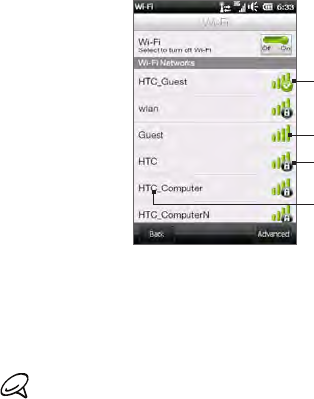
166 Chapter 9 Internet and Social Networking
If you selected a secured network, enter the security key and
then tap Done. You are then connected to the network.
Indicates a
secured Wi-Fi
network.
Indicates that
your phone is
connected to this
Wi-Fi network
Signal strength
Network name
(SSID)
4. Tap Back to return to the previous screen.
Next time you use your phone to detect Wi-Fi networks, you will not
be prompted to enter the network key of the previously accessed
Wi-Fi network (unless you perform a hard reset which will erase
custom settings on your phone).
Wi-Fi networks are self-discoverable, which means no additional
steps are required for your phone to connect to a Wi-Fi network. It
may be necessary to provide a username and password for certain
closed wireless networks.
To turn off Wi-Fi, on the Wireless controls screen, tap the Off/On
switch at the right side of the Wi-Fi item.
•
•
•
Chapter 9 Internet and Social Networking 167
To add a wireless network
1. On the Home screen, slide to the Settings tab and then tap Menu
> All Settings.
2. Tap Connections > Wi-Fi > Adaptor and Networks. The Wi-Fi
screen then opens.
3. Tap Add New (or Menu > Add New) and enter the details for
connecting to the wireless network.
To set your phone to turn off Wi-Fi automatically
Wi-Fi quickly consumes battery power. Manually turn off Wi-Fi when
not in use. You can also set your phone to automatically turn off Wi-Fi
after a specified timeout period.
1. On the Home screen, slide to the Settings tab and then tap Menu
> All Settings.
2. Tap Connections > Wi-Fi > Adaptor and Networks.
3. On the Wi-Fi screen, tap Menu > Advanced.
4. Select the timeout period for automatically turning off Wi-Fi
when your phone is not connected to any wireless network.

168 Chapter 9 Internet and Social Networking
GPRS/3G
Use GPRS/3G (or EDGE, if available) to connect to the Internet and
to send and receive email on your phone. You will need a data plan to
use your mobile operator’s GPRS/3G network. Check with your mobile
operator to find out about GPRS/3G rates.
Your phone automatically sets up the data connection based on your
SIM card when you turn on the phone for the first time. Do not change
the connection settings as this may cause services to stop working. If
you need to add another GPRS/3G connection on your phone, contact
your mobile operator.
You can also manually select the mobile operator to use for data
connections. See “Using Connection Setup” in Chapter 14 for details.
Dial-up
To set up a dial-up connection to your Internet Service Provider (ISP)
on your phone, you need the same settings that you normally use when
you dial up from your computer. This includes the ISP server phone
number, your user name and password.
1. On the Home screen, slide to the Settings tab and then tap
Wireless controls.
2. Tap Menu > Connections and then tap Add a new modem
connection.
3. In the Select a modem list, select Cellular Line, and then tap
Next.
4. Enter the ISP server phone number, and then tap Next.
5. Enter your user name, password, and any other information
required by your ISP, and then tap Finish.
Chapter 9 Internet and Social Networking 169
Starting a data connection
After setting up a data connection such as GPRS/3G or ISP dial-up
on your phone, you can now connect your phone to the Internet. The
connection is automatically started when you begin using a function
that accesses the Internet such as email or the Web browser.
To manually start a data connection
If you have several types of data connections on your phone, you can
manually start a connection.
1. On the Home screen, slide to the Settings tab and then tap
Wireless controls.
2. Tap Menu > Connections and then tap Manage existing
connections.
3. Press and hold the name of the desired connection, and then tap
Connect.
To disconnect an active data connection
1. On the Home screen, slide to the Settings tab, and then tap
Wireless controls.
2. Tap the Off/On switch at the right side of the Data connection
item.
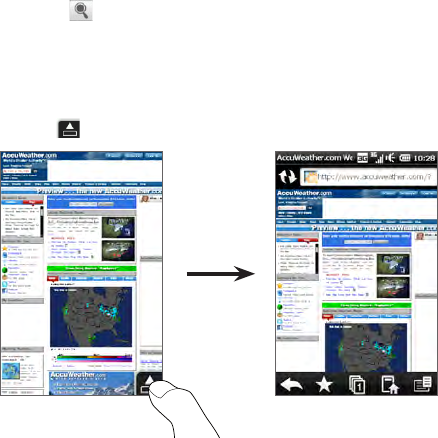
170 Chapter 9 Internet and Social Networking
9.2 Using Opera Mobile
Opera Mobile™ is a full-featured Internet browser, optimized for use on
your phone.
On the Home screen, slide to the Internet tab and then tap Launch
Browser to open Opera Mobile. From the Internet tab, you can also
enter a search keyword first on the search box and then tap the
Search button ( ) to do a Web search in Opera Mobile.
The browser screen
Opera Mobile displays in two modes: full-screen and normal viewing
modes. Full-screen mode hides the address bar and the browser
controls. To change from full-screen to normal viewing mode, tap the
Restore icon ( ) at the bottom right corner of the browser screen.
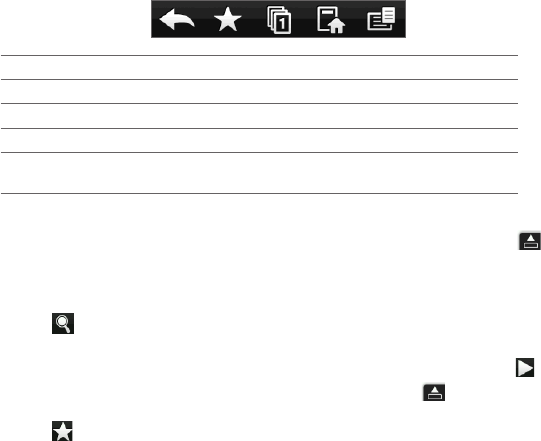
Chapter 9 Internet and Social Networking 171
In normal viewing mode, you can use the following browser controls:
1 2 3 4 5
1Return to the previous Web page viewed.
2Add, edit, or delete Web favorites.
3Add a new browsing tab or switch to another browsing tab.
4Go to the home page.
5Open the browser menu and choose display settings, save Web
pages, and more. See “Opera Mobile menu” for details.
Searching for a website and adding it to favorites
1. If Opera Mobile is in full-screen mode, tap the Restore icon ( ).
2. To search for information on the Web and select a website that
you want, tap the address bar, enter a search keyword in the
search box below the address bar, and then tap the Search icon
( ).
Otherwise, if you know the Web address, tap on the address bar,
enter the address of the website, and then tap the Go icon ( ).
3. After browsing a website, tap the Restore icon ( ) again to
display the browser controls, and then tap the Favorites icon
( ).
4. Tap Add Favorite.
5. Use the provided title or enter a descriptive title for the website.
6. To save the website address as a favorite, tap Done.
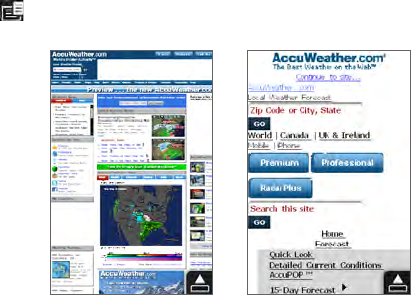
172 Chapter 9 Internet and Social Networking
Mobile view
When you open a Web page in Opera Mobile, the page is displayed
in desktop view and text may appear in the smallest size. To reformat
Web pages to fit the screen of your phone so that the content is
readable, set Opera Mobile to display in mobile view.
Tap > Settings > Display, and then select the Mobile view check
box.
Desktop view Mobile view
Zooming and panning
Use pinch zooming to easily zoom in and out of a Web page. Press
both your thumb and index finger on the touch screen and then
spread your fingers apart to zoom in. Pinch your fingers together to
zoom out.
While zoomed in, drag your finger in any direction to move around the
Web page.
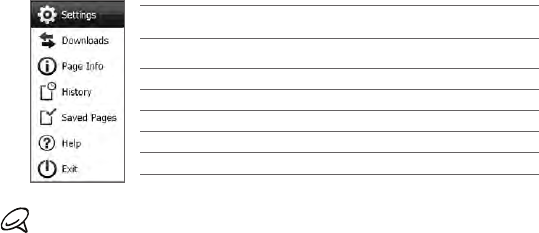
Chapter 9 Internet and Social Networking 173
Opera Mobile menu
1
2
3
4
5
6
7
1Open the Settings screen where you can set your home
page, change display settings, set privacy settings, and more.
2View items being downloaded, and resume or stop current
downloads.
3View information about the Web page you are browsing.
4See Web pages that you have viewed.
5Manage and view Web pages that you have saved.
6Open the Opera Mobile help file.
7Close Opera Mobile completely.
For more information about using Opera Mobile, go to:
http://www.opera.com/products/mobile/.
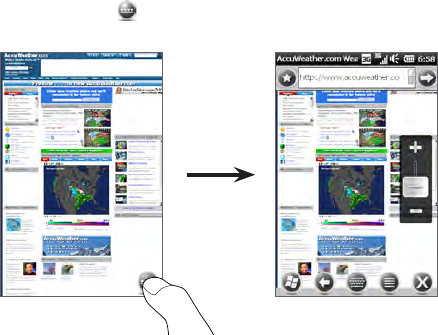
174 Chapter 9 Internet and Social Networking
9.3 Using Internet Explorer Mobile
Internet Explorer Mobile is the standard Web browser that is included
with Windows Mobile. To use Internet Explorer Mobile, press START and
then tap Internet Explorer.
The browser screen
Internet Explorer Mobile displays in two modes: full-screen and normal
viewing modes. Full-screen mode hides the address bar and the
browser controls. To change from full-screen to normal viewing mode,
tap the Restore icon ( ) at the bottom right corner of the browser
screen.

Chapter 9 Internet and Social Networking 175
In normal viewing mode, you can use the following browser controls:
1 2 3 4 5
1Open the Start screen.
2Return to the previous Web page viewed.
3Display or hide the onscreen keyboard of your phone.
4Open the browser menu and choose display options and other
settings.
5Close Internet Explorer Mobile.
Entering a website address and adding it to your
favorites
1. If Internet Explorer is in full-screen mode, tap the Restore icon
( ).
2. Tap on the address bar, enter the address of the website, and
then tap the Go icon ( ).
3. After browsing the website, tap the Restore icon ( ) again
to display the browser controls, and then tap the Favorites
icon ( ) to the left of the address bar.
4. Tap Add Favorite.
5. Use the provided title or enter a descriptive title for the website.
6. To save the website address as a favorite, tap Done.
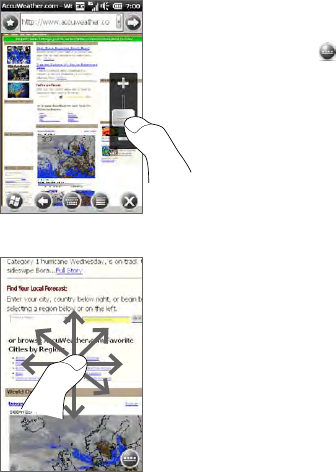
176 Chapter 9 Internet and Social Networking
Zooming and panning
If Internet Explorer is in full-screen mode, tap
the Restore icon ( ).to display and use the
onscreen zoom slider. While viewing a Web
page, slide your finger up on the onscreen
zoom slider to zoom in, or slide down to
zoom out.
While zoomed in, drag your finger in any
direction to move around the Web page.
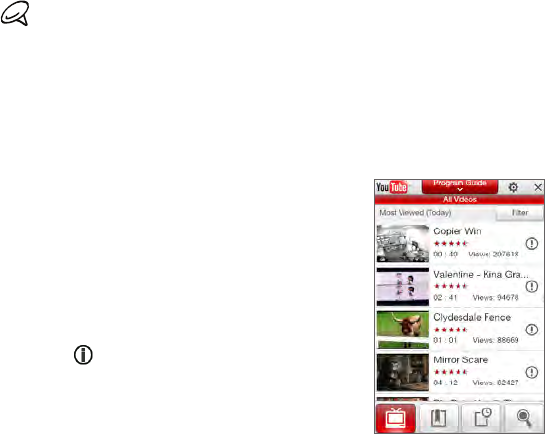
Chapter 9 Internet and Social Networking 177
9.4 Using YouTube
YouTube™ lets you browse, search, and watch Internet videos that
are posted in YouTube. To open YouTube, press START and then tap
YouTube.
You need an active data or Wi-Fi connection to use YouTube. If you
are using a GPRS/3G connection, watching Internet videos may
significantly increase your data connection costs.
The YouTube main screen
Slide your finger up or down the main screen to browse through the
most popular YouTube videos. You can browse for more videos by
tapping Download at the bottom of the video list.
On the YouTube main screen, you can:
Tap Filter to filter the list by type of
video (Featured, Most Viewed, Top
Favorited, or Top Rated) and by the
time period when videos were uploaded
to the YouTube server.
Use the Program Guide if you want to
browse videos by channels. See “Using
the Program Guide” for details.
Tap to view details about a video.
Tap a video to watch it. See “Watching
videos” for details.
Tap the tabs at the bottom to switch
between the different YouTube screens:
Main screen, Bookmarks, History, and
Search.
•
•
•
•
•
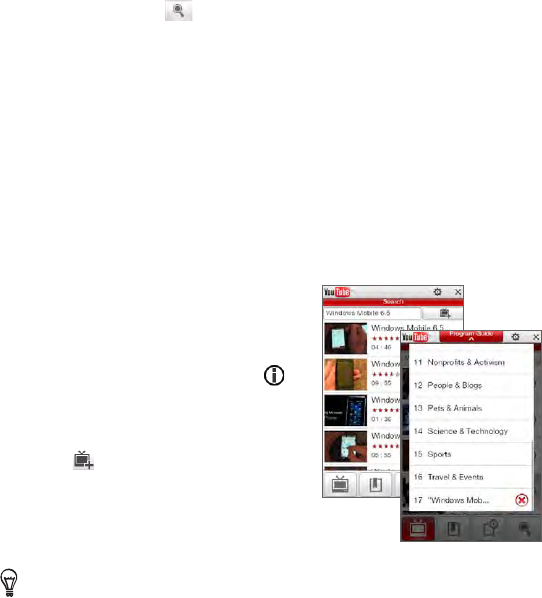
178 Chapter 9 Internet and Social Networking
Searching for videos
Tap the Search tab ( ) to open the Search screen where you can
specify your criteria for searching for YouTube videos.
1. On the Search screen, enter the video information, and then tap
Search.
YouTube searches for the video, and then displays all related
videos on the screen.
2. Tap a video to watch it. See “Watching videos” for details.
Using the Program Guide
The Program Guide categorizes videos into channels so you can
browse and watch related videos available on YouTube. You can also
add your favorite video channel in the Program Guide.
To add a new channel
1. Search the channel or video you
want to add to the Program Guide.
See “Searching for videos” for
details.
2. In the search results list, tap
at the right side of the video
or channel to open the details
screen.
3. Tap , and then tap OK on the
confirmation screen.
The channel you just subscribed
to is shown when you tap
Program Guide.
You can also add search information as
a program channel.
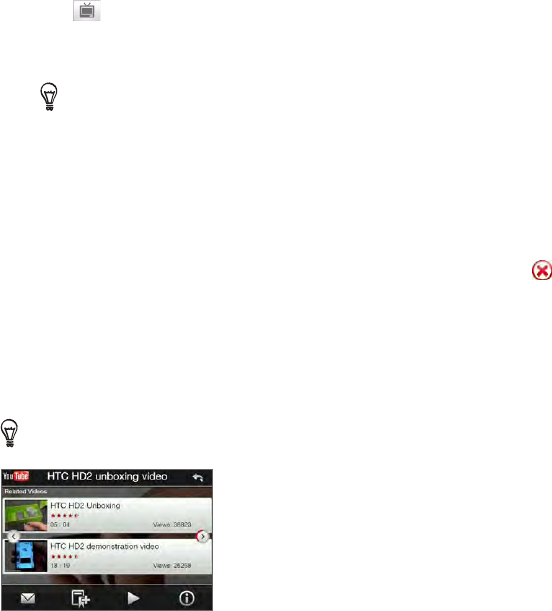
Chapter 9 Internet and Social Networking 179
To change the program channel
1. Tap to return to the main screen and then tap Program Guide
on top of the screen.
2. On the Program Guide, select a channel.
You can scroll down to view more channels.
The video list refreshes to display the available videos for the
selected channel.
To delete a program channel
You can only delete channels that you have added to the Program
Guide.
1. Tap Program Guide.
2. Scroll down to the channel that you want to delete, and then tap .
3. On the confirmation screen, tap Yes.
Watching videos
Tap a video on any YouTube screen, program guide channel, or search
results list to launch the YouTube Video Player. Use the onscreen
controls at the bottom of the player to control the playback.
To adjust the volume, press the VOLUME UP and VOLUME DOWN buttons
on the left panel of the phone.
After you stopped or finished
watching the video, you can add
the video to Bookmarks, send the
link to this video by email, choose
to watch other related videos, and
more.
180 Chapter 9 Internet and Social Networking
9.5 Using Streaming Media
Streaming Media lets you stream live broadcasts or on-demand media
content from the Web. The media is sent in a continuous stream to
your phone and is played as it arrives, along with the audio.
The Streaming Media program allows you to play 3GP and MPEG-4
files. It also supports playback of SDP (Session Description Protocol)
files.
To access streaming content via the Web browser
Using the Web browser on your phone, you can open a Web page
containing RTSP (Real Time Streaming Protocol) links to streaming
media content then play the content in the Streaming Media program.
1. On the Home screen, slide to the Internet tab and tap Launch
Browser.
2. In the address bar, enter the URL address of the Web page that
contains the RTSP link to the desired *.3gp, *.mp4, or *.sdp file.
3. On the Web page, tap the RTSP link.
4. Streaming Media then automatically opens and starts playing the
file. During playback, use the slider and button controls to play/
pause, fast forward, view the video in actual size, expanded size,
or full screen, and more.
To stream media files directly on the Streaming Media Player
Streaming Media only supports RTSP links when you stream *.3gp and
*.mp4 files directly on the program.
1. Press START and then tap Multimedia> Streaming Media.
2. Tap Menu > Connect.
3. Enter the complete RTSP link, and then tap Done. Streaming
Media starts playing the file.
Chapter 9 Internet and Social Networking 181
4. During playback, use the slider and playback control buttons to
play/pause, switch to full screen, fast forward, and more.
To configure streaming video connection settings
Tap Menu > Options to configure the Streaming Media settings. From
this screen, you can set the media buffer, select the connection to use,
set all streaming videos to play in full screen, and more.
9.6 Using Windows Live
Windows Live helps you quickly find information using Windows Live
Search, access and sync your Windows Live Mail and contacts, and
send instant messages using Windows Live Messenger.
To set up Windows Live for the first time
1. Press START and then tap Windows Live.
2. Tap Sign in to Windows Live.
3. Tap the links to read the Windows Live Terms of Use and the
Microsoft Online Privacy Statement. After reviewing them, tap
Accept.
4. Enter your Windows Live Mail or Hotmail address and password,
select the Save password check box, and then tap Next.
5. Tap Next.
6. Choose what information you want to sync online with your
phone.
If you select Store Windows Live contacts in your mobile phone’s
contact list, your Windows Live contacts will be added to the
contact list and to Windows Live Messenger on your phone.
If you select Sync e-mail, your Windows Live Mail or Hotmail
inbox messages will be downloaded to your phone.
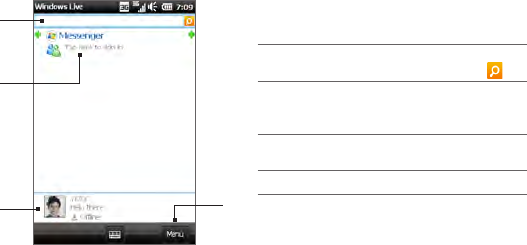
182 Chapter 9 Internet and Social Networking
7. Tap Next.
8. After synchronization is complete, tap Done.
The Windows Live screen
1
3
2
4
1
Search bar. Enter the information
you want to search, then tap .
2
Switch between the Windows
Live Messenger, Windows Live
Mail, and Sync status screens.
3
Change your display name,
picture, and personal message.
4
Adjust Windows Live settings.
Using Windows Live Messenger
With this mobile version of Windows Live Messenger, you can send
and receive instant messages.
To sign in to Windows Live Messenger and start a conversation
1. Tap Messenger on the Windows Live screen.
2. Tap Sign in on the Messenger screen. Signing in may take several
minutes, depending on your connection speed.
3. In the contact list, select an online contact, and then tap Send IM
to open the message screen.
Chapter 9 Internet and Social Networking 183
4. On the message screen, enter your message in the text field,
then tap the Enter key on the onscreen keyboard to send the
message. You can also do any of the following on the message
screen:
To add an emoticon, tap Menu > Add emoticon, then tap an
emoticon on the screen. The emoticon is attached to your
message.
To send a file, tap Menu > Send, select the type of file (picture,
voice clip, or any file), and then locate the file you want to
send.
To invite one or more contacts to the conversation, tap Menu
> Options > Add participant.
To send a voice message, tap Voice clip on the message
screen, then start talking. When you have finished recording,
tap Send.
5. To end the conversation with the current contact, tap Menu > End
conversation.
6. To sign out, tap Menu > Sign out.
To add a Windows Live contact
You can add new Windows Live contacts in Windows Live Messenger.
1. Tap Menu > Add new contact.
2. Enter the email address of the contact, and then tap OK.
•
•
•
•
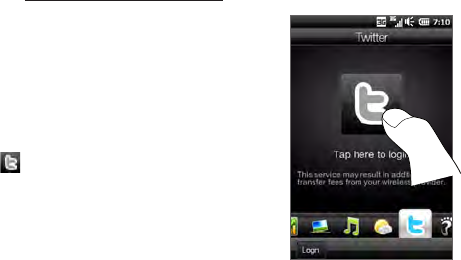
184 Chapter 9 Internet and Social Networking
9.7 Twittering on Your Phone
Share your thoughts with people in Twitter anytime, anywhere.
Directly from your Home screen’s Twitter tab, it is simple and
convenient to use this popular Internet social networking service.
Logging in to your Twitter account
If you do not have a Twitter account yet, you can sign up for free on
the following Twitter website using your computer or your phone’s
Web browser: http://twitter.com/signup.
If you did not log into your Twitter
account when you turned on and set up
your phone for the first time, the Home
screen’s Twitter tab allows you to log in
to Twitter.
1. On the Home screen, slide to the
Twitter tab, and then tap the Twitter
icon ( ) on the center screen.
2. Enter the user name or email
address and the password that you
use for your Twitter account. Select
the Remember me check box to
store your login information so you
do not have to re-enter it the next
time you log in.
3. Tap Login.
Once you are logged in, you’re ready to
send and follow tweets on your phone.
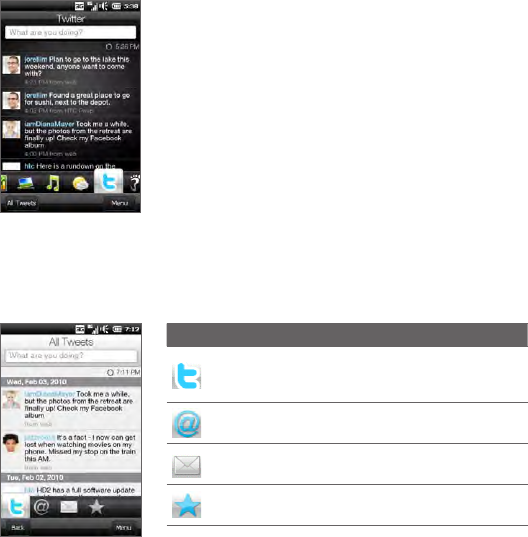
Chapter 9 Internet and Social Networking 185
Viewing tweets
On the Home screen’s Twitter tab, you can see
tweets of the people that you follow and your
sent tweets, starting with the most recent.
Swipe your finger up or down the screen to
scroll through the tweets.
To use more Twitter functions, tap any tweet or
tap All Tweets at the bottom of the screen.
The All Tweets screen opens, listing all tweets organized by date. Tap
a tweet to access more Twitter functions, such as sending replies or
direct messages, viewing someone’s profile, and more. You can also
tap or slide across the tabs on the bottom row to change among the
following types of tweets:
Tabs Function
All Tweets
Shows tweets from all the Twitter
users you follow and the tweets
that you sent grouped by date.
Mentions Shows only tweet responses that
people addressed to you.
Direct
Messages
Shows private messages sent
to you.
Favorites Shows tweets you have marked
as favorites.

186 Chapter 9 Internet and Social Networking
Sending tweets
You can send tweets either from the Home screen’s Twitter tab or
from the All Tweets screen.
1. Tap the text box that shows the words “What are you doing?”
2. On the subsequent screen, enter your tweet message.
3. In your tweet, you can also share your photo and location
information. See “Sharing a photo in Twitter” for details.
4. Tap Update to send your tweet.
Sending mentions and direct messages
A mention (reply) is just the same as any tweet message, except that
it’s specifically addressed to a person and his or her name will appear
in your sent tweet. A direct message is a private message sent to
someone and cannot be seen by everyone else in Twitter.
1. On the Home screen, slide to the Twitter tab and then tap All
Tweets.
2. Tap a tweet from the person whom you want to send a reply or
direct message.
3. In the Options menu, choose the type of tweet (Reply or Direct
Message) you want to send.
4. Enter your message and then tap Update to send it.
Searching for Twitter users to follow
You can search for people or topics of interest and follow them so you
can readily see their latest tweet updates on your phone.
1. From the Home screen’s Twitter tab or the All Tweets screen, tap
Menu > Search.
2. Tap the text box that shows the words “Search tweet”. Enter the
Twitter username or a search keyword, and then tap the Search
button ( ).

Chapter 9 Internet and Social Networking 187
3. From the search results, tap the photo of the person or topic you
want to follow.
4. The Profile screen is then displayed, showing details about the
person or topic. Tap Follow.
If you want to stop following a certain Twitter user or topic, go back to
the All Tweets screen, tap the photo of that user or topic, and then tap
Unfollow.
Sharing a photo in Twitter
Photos that you share on Twitter are uploaded to a photo hosting
service that’s specified in your phone’s Twitter settings. To find out
how to select the hosting service, see “Changing Twitter settings”.
You can upload only one photo at a time. Create a new tweet first,
and then select a photo or use the Camera to take a photo. The URL
location of your photo will be inserted into your tweet message.
1. Create a new tweet. See “Sending tweets” for instructions.
2. On the screen where you’ve entered your tweet message, tap the
Camera button ( ).
3. Browse through your photos. If you do not see the photo that
you want, tap Albums and select the album that contains the
photo you want to share.
4. When you see the photo that you want, tap the photo to select
it. You can also tap the Camera icon ( ) to take a photo using
your phone’s Camera.
5. Your phone then begins uploading the photo to the Twitter
photo host. When the upload is done, the URL location of the
photo is then entered to your tweet message.
6. Tap Update to send your tweet along with the URL of the photo
so other people can see it in Twitter.

188 Chapter 9 Internet and Social Networking
When you return to the Home screen’s Twitter tab and tap All Tweets,
you will see the sent tweet that contains the URL of your shared
photo.
Changing Twitter settings
On the Home screen’s Twitter tab or the All Tweets screen, tap
Menu > Settings when you want to change the number of tweets to
download, download time, photo hosting site, URL shortening host,
and more.
Logging out of Twitter
While your phone is connected to the Internet, you’re always logged
on to your Twitter account on your phone. You can log out of Twitter
from the Home screen’s Twitter tab.
1. On the Home screen, slide to the Twitter tab.
2. Tap Menu > Settings.
3. To log out, tap your Twitter account name and then tap Yes.
You can also log out of Twitter from the Home screen’s Settings tab. From
this tab, tap Data services > Twitter > Logout and then tap Yes.

Chapter 9 Internet and Social Networking 189
9.8 Sharing Photos and Videos on Facebook,
Twitter, and YouTube
Directly from your phone, you can easily share your photos on
Facebook and Twitter. You can also upload videos to YouTube.
Logging into your social networks
If you skipped setting up your social network accounts when you
turned on your phone for the first time, you need to log in first to your
accounts before you can upload and share your photos and videos.
1. On the Home screen, slide to the Settings tab and then tap Data
services.
2. Log in to Facebook, YouTube, and Twitter one at a time. Tap the
name of the social network you want to log in to, and then tap
Login.
3. On the subsequent screen, enter your username and password.
Select the Remember me check box if you want to store your
login information so you do not have to re-enter it the next time
you log in. Tap Login.
Uploading photos to Facebook
After taking a photo with your phone’s Camera, you can upload the
photo to Facebook. Use Albums when you want to upload several
photos at the same time.
1. Open the Camera and take a photo. For instructions, see “Taking
Photos and Videos” in Chapter 12.
2. After taking a photo, tap the Send icon ( ), select Upload to
Facebook, and then tap Send.
3. To share several photos, slide to the Photos & Videos tab on the
Home screen, and then tap Albums.

190 Chapter 9 Internet and Social Networking
In Albums, tap Menu > Share > Facebook, tap each of the photos
you want to share, and then tap Upload.
After upload is complete, you can check and view your Facebook
photos in Albums. See “Viewing Facebook photos” in Chapter 12 for
details.
Uploading a photo to Twitter
You can upload only one photo at a time to Twitter and share the URL
location of the photo in your sent tweet. To find out how to upload
your photo to Twitter, see “Sharing a photo in Twitter” in this chapter.
Uploading videos to YouTube
You can use Camera to capture a video and immediately share it on
YouTube. Use Albums when you want to upload several videos at the
same time.
1. Open the Camera and capture a video. For instructions, see
“Taking Photos and Videos” in Chapter 12.
2. After capturing a video, tap the Send icon ( ), select Upload to
YouTube, and then tap Send.
3. On the Video Upload screen, enter a descriptive title and tags for
the video. Also tap the Off/On switch to set whether to make this
video public to everyone.
4. Tap Upload.
5. To share several videos, slide to the Photos & Videos tab on the
Home screen, and then tap Albums. In Albums, tap Menu > Share
> YouTube, tap each of the videos you want to share, and then
tap Next. Follow steps 3 and 4 above to upload the videos to
YouTube.
After upload is complete, use the Web browser to log into your
YouTube account if you want to check and view the uploaded videos.
You will find them grouped under “My Videos”.
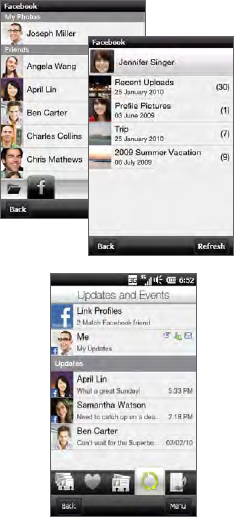
Chapter 9 Internet and Social Networking 191
9.9 Using Facebook on Your Phone
Using Albums on your phone, you
can view yours and other people’s
Facebook albums and photos. For
more information, see “Viewing
Facebook photos” in Chapter 12.
Your phone notifies you about what’s
happening with your Facebook
world. On your phone, you can check
whether there are new updates and
events in your Facebook and see
what’s happening with other people.
For more information, see “Facebook
Updates and Events” in Chapter 4.
192 Chapter 9 Internet and Social Networking
9.10 Using Your Phone as a Modem
If you do not have Internet access on your desktop or notebook
computer, you can connect your computer to the Internet by using
your phone’s data connection such as GPRS/3G. You can connect via
USB or Bluetooth.
Before you proceed
Make sure your phone has a SIM card installed, and your phone
has a GPRS/3G or dial-up modem connection. For more
information about setting up these connections, see “GPRS/3G”
and “Dial-up” in this chapter.
To set up your phone as a USB modem, you must first install
Windows Mobile Device Center or Microsoft ActiveSync version
4.5 or later on the computer.
To use a Bluetooth connection, make sure your computer has
built-in Bluetooth capability. If your computer does not have
Bluetooth, you can connect and use a Bluetooth adapter or
dongle.
Setting up your phone as a USB modem
1. Connect the phone to your desktop or notebook computer using
the USB sync cable.
2. When the Connect to PC screen appears, select Internet Sharing,
and then tap Done.
The Internet Sharing screen then opens and automatically
connects your computer to the Internet using your phone.
•
•
•
Chapter 9 Internet and Social Networking 193
Using your phone as a Bluetooth modem
To use your phone as a Bluetooth modem for your computer, set up
a Bluetooth Personal Area Network (PAN) between your phone and
your computer.
To set up Bluetooth PAN on your phone
1. On your phone, turn on Bluetooth and set it to visible mode. For
instructions, see “Turning Bluetooth on and making your phone
visible” in Chapter 10.
2. Initiate a Bluetooth partnership from your phone. For instructions,
see “Creating a Bluetooth partnership” in Chapter 10.
3. Set up Bluetooth PAN on your computer. For instructions, see “To
set up Bluetooth PAN on your computer”.
4. On your phone, tap Accept to connect to your computer.
A connected status message is displayed, which indicates that your
computer has been successfully connected to the Internet using your
phone as a Bluetooth modem.
To set up Bluetooth PAN on your computer
For Windows 7:
1. Click Start > Control Panel > Network and Internet > Network
and Sharing Center.
2. Under Change your networking settings, click Set up a new
connection or network.
3. Click Connect to a Bluetooth personal area network (PAN), and
then click Next.
4. In the Bluetooth Personal Area Network Devices dialog box,
select your phone and then click Connect using > Direct
connection.

194 Chapter 9 Internet and Social Networking
For Windows Vista:
1. Click Start > Control Panel > Network and Sharing Center.
2. Click Manage network connections and then under Personal
Area Network, double-click Bluetooth Network Connection.
3. In the Bluetooth Personal Area Network Devices dialog box,
select your phone, and click Connect.
For Windows XP:
1. Click Start > Control Panel > Network Connections.
2. Under Personal Area Network, click the Bluetooth Network
Connection icon.
3. Under Network Tasks, click View Bluetooth network devices.
4. In the Bluetooth Personal Area Network Devices dialog box,
select your phone, and click Connect.
If the Bluetooth adapter or dongle on your computer was
installed using a third-party driver, open the Bluetooth software
that came with the Bluetooth adapter/dongle to connect your
computer and phone via Bluetooth. Refer to the Bluetooth
adapter/dongle documentation for more information.
Ending the Internet connection
For a USB connection
On the Internet Sharing screen, tap Disconnect.
For a Bluetooth connection
On the Private Networking screen, tap Menu > Remove.
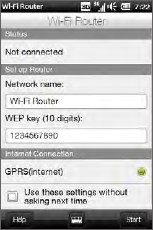
Chapter 9 Internet and Social Networking 195
9.11 Using Your Phone as a Wireless Router
Wi-Fi Router turns your phone into a wireless router and shares your
phone’s data connection over Wi-Fi with one or more computers.
When you start Wi-Fi Router, your phone creates a secure Wi-Fi
network that you can connect to with your computer and access the
Internet.
To use your phone as a wireless router, make sure your phone has a
SIM card installed and has a 3G/GPRS/EDGE data connection. To
connect to your phone’s Wi-Fi network, you need a computer with
built in Wi-Fi or a Wi-Fi adapter.
Setting up your phone as a wireless router
1. From the Home screen, slide to the Settings tab and then tap
Wireless controls > Wi-Fi Router, or press START and then tap
Wi-Fi Router.
2. The first time you open Wi-Fi Router, a brief introduction
describing the application is displayed. Scroll down and tap Next.
3. On the Wi-Fi Router screen, enter a
Network name for the Wi-Fi network you
want to create, or use the provided default
name.
4. Enter a WEP key to use to secure the Wi-Fi
network, or use the provided default WEP
key. The WEP key must be 10 digits long.
5. Under Internet Connection, select the
name of the connection your phone uses to
access the Internet.

196 Chapter 9 Internet and Social Networking
6. Tap Start. When the phone is ready to accept connections, it
displays instructions for connecting a computer to the Wi-Fi
network. Once a computer connects, the instructions disappear
and the Wi-Fi Router screen is displayed again.
You can tap Help to display the connection instructions again.
Connecting your computer to your phone’s Wi-Fi
network
After setting up your phone as a wireless router, connect your
computer to your phone via Wi-Fi to access the Internet.
For Windows 7
1. Click Start > Control Panel > Network and Internet > Network
and Sharing Center.
2. Under Change your networking settings, click Connect to a
network.
3. Select the name of your phone’s Wi-Fi network, and then click
Connect.
4. Enter the WEP key you used when setting up Wi-Fi Router and
then click OK.
For Windows Vista
1. Click Start > Connect To.
2. In the Connect to a network dialog box, select the name of your
phone’s Wi-Fi network, and then click Connect.
Your phone’s wireless network may not show up in the list of
available networks immediately. Wait for a moment and then
refresh the list to see the wireless network.

Chapter 9 Internet and Social Networking 197
3. Enter the WEP key you used when setting up Wi-Fi Router and
then click Connect.
4. Click Close.
For Windows XP
1. Click Start > Connect To > Wireless Network Connection.
2. In the Choose a Wireless Network dialog box, select the name of
your phone’s Wi-Fi network, and then click Connect.
Your phone’s wireless network may not show up in the list of
available networks immediately. Wait for a moment and then
refresh the list to see the wireless network.
3. Enter the WEP key you used when setting up Wi-Fi Router and
then click Connect.
Turning off your phone’s Wi-Fi network
On the Wi-Fi Router screen, tap Stop.
Turning on your phone’s Wi-Fi network in Comm
Manager
Once your phone has been set up as a wireless router, you can easily
turn the Wi-Fi network on and off in Comm Manager.
1. From the Home screen, slide to the Settings tab and then tap
Wireless controls.
2. Tap the Off/On slider at the right side of the Wi-Fi Router
item. When the wireless router starts and is ready to accept
connections, the wireless network name and WEP key are
displayed.

Chapter 10
Bluetooth
10.1 Bluetooth Modes
Bluetooth is a short-range wireless communications technology.
Devices with Bluetooth capabilities can exchange information over a
distance of about eight meters (26 feet) without requiring a physical
connection.
Bluetooth on your phone operates in three different modes:
On. Bluetooth is turned on. Your phone can detect other
Bluetooth-enabled devices, but not vice versa.
Visible. Bluetooth is turned on, and all other Bluetooth-enabled
devices can detect your phone.
Off. Bluetooth is turned off. In this mode, you can neither send
nor receive information using Bluetooth.
Turn off Bluetooth when not in use to conserve battery power, or in
places where using a wireless device is prohibited, such as on board an
aircraft and in hospitals.
•
•
•

Chapter 10 Bluetooth 199
Turning Bluetooth on and making your phone visible
Turn Bluetooth on and make your phone visible (discoverable) when
you want other Bluetooth-enabled devices to detect and connect with
your phone.
1. On the Home screen, slide to the Settings tab, and then tap Menu
> All Settings > Bluetooth.
2. When prompted to turn on Bluetooth, tap Yes.
3. Tap the Settings tab ( ), and then tap Not Discoverable.
4. Select Always Visible.
If you select Visible for 60 seconds, Bluetooth visibility will turn
off automatically when the time elapses and your phone has not
yet connected to another Bluetooth device.
5. Tap Done. The icon then appears in the title bar to indicate
that your phone is in visible mode.
To easily switch Bluetooth off or back on, tap Wireless controls on the
Home Screen’s Settings tab to open the Comm Manager and then tap
Bluetooth’s Off/On switch.
Your phone remembers whether visible mode was previously enabled or
disabled. If you did not disable visible mode, switching Bluetooth on in the
Comm Manager also puts your phone in visible mode automatically. For
more information about using the Comm Manager, see Chapter 14.

200 Chapter 10 Bluetooth
10.2 Bluetooth Partnerships
A Bluetooth partnership is a relationship that you create between your
phone and another Bluetooth-enabled device in order to exchange
information in a secure manner.
Creating a Bluetooth partnership
1. On the Home screen, slide to the Settings tab, and then tap
Wireless controls > Bluetooth. Your phone then starts searching
for other Bluetooth devices.
2. Tap a Bluetooth device to connect with.
3. If prompted, enter the same passcode on both your phone and
the other device, or confirm the auto-generated passcode.
4. After the receiving party accepts the partnership, the Bluetooth
device name is shown on your screen, including all Bluetooth
services that you can use with it. Select the check boxes of the
Bluetooth services you want to use, and then tap Done.
5. If you selected to use the Bluetooth Serial Port service of the
paired device, select a local serial port to assign for the paired
device, and then tap Continue.
When you tap Menu > All Settings > Bluetooth on the Home screen’s
Settings tab, you will see the connected Bluetooth device listed in the
Devices tab ( ).
Tap Properties to change the paired device name. Tap Menu > Update to
update the list of services that you can use with the paired device.
Creating a Bluetooth partnership is a one-time process. Once
a partnership is created, your phone and the paired device can
recognize the partnership and exchange information without entering
a passcode again.

Chapter 10 Bluetooth 201
Accepting a Bluetooth partnership
1. Ensure that Bluetooth is turned on and in visible mode.
2. When prompted, enter or accept the passcode (the same
passcode from the device requesting the partnership) to
establish a secure connection.
3. Tap OK. The paired device now appears in the Devices
tab ( ). You can now exchange information with the
paired device.
To delete a Bluetooth partnership, select the device’s name on the
Devices tab, then tap Menu > Delete. When prompted to confirm, tap
Yes.

202 Chapter 10 Bluetooth
10.3 Connecting a Bluetooth Hands-free or Stereo
Headset
For hands-free phone conversations, you can use a Bluetooth
hands-free headset such as a car kit with your phone. Your phone
also supports A2DP (Advanced Audio Distribution Profile) which
allows you to use a Bluetooth stereo headset for hands-free phone
conversations and for listening to stereo music.
1. Make sure that both your phone and the Bluetooth headset are
turned on and within close range, and that the headset is visible.
Refer to the manufacturer’s documentation to find out how to set
the headset in visible mode.
2. On the Home screen, slide to the Settings tab, and then tap
Wireless controls > Bluetooth. Your phone then starts to search
for the Bluetooth headset.
3. Tap to select the hands-free or stereo headset from the list. Your
phone will automatically pair with the Bluetooth headset.
Your phone will automatically try one of the preconfigured
passcodes (0000, 8888) to pair with the Bluetooth headset. If
this fails, you have to manually enter the passcode delivered with
your headset.
4. When connected, the hands-free or stereo headset is shown on
your screen, including the Bluetooth services (Hands-free and
Stereo Audio) that you can use with it. Make sure these services
are selected, and then tap Done.
The paired headset now appears in the Devices tab ( ).
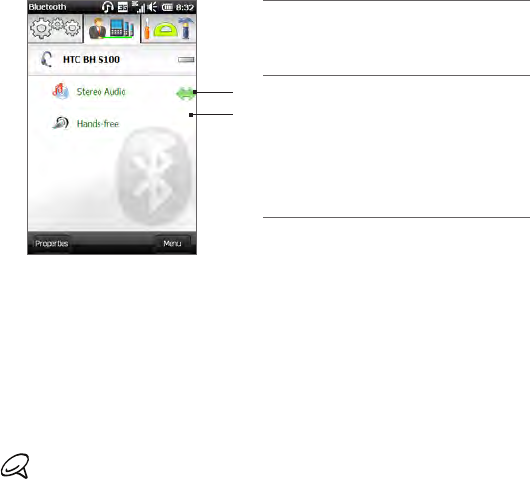
Chapter 10 Bluetooth 203
1The double arrowhead that is
displayed to the right of a service
indicates that the service is
connected with your headset.
2If you turn off your headset, the
double arrowhead disappears to
indicate that the service has been
disconnected. Next time you turn
on and use your headset again,
you need to manually reconnect
each service. Tap a service to
reconnect.
1
2
10.4 Sending and Receiving Information Using
Bluetooth
You can send the following types of information from your phone to
your computer or to another Bluetooth-enabled device: Outlook email,
contacts, tasks, notes, calendar items, audio files, ringtones, images,
and videos.
If your computer does not have built-in Bluetooth capability, you need
to connect and use a Bluetooth adapter or dongle on your computer.
Sending information from your phone to a computer
1. Set the receiving device to discoverable mode. You may also
need to set it to “Receive Beams” or “Receive Files”. Refer
to the device’s documentation for instructions on receiving
information over Bluetooth.
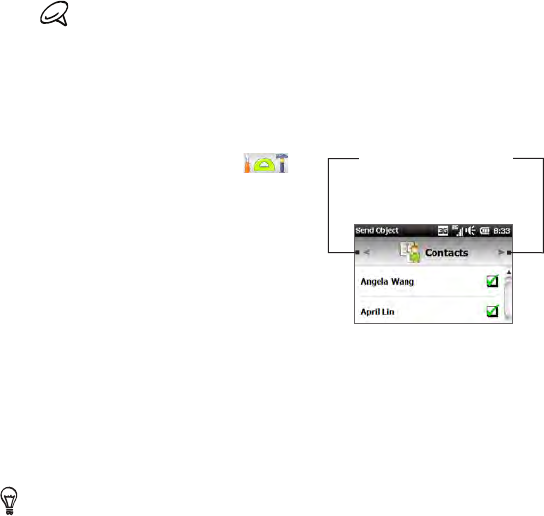
204 Chapter 10 Bluetooth
If the Bluetooth adapter or dongle on your computer was
installed using a third-party provided driver, open the Bluetooth
software that came with the Bluetooth adapter/dongle and
enable the adapter/dongle to be discovered by other devices.
Refer to the Bluetooth adapter’s documentation for more
information.
2. On the Home screen, slide to the Settings tab, and then tap Menu
> All Settings > Bluetooth.
3. Tap the Accessories tab ( ),
and then tap BT Send Object.
4. Select the type of information
and then select the check boxes
of items you want to send.
5. Tap Send.
6. Tap to select the Bluetooth
device to which you want to send
the items.
Tap the left or right arrow
to change to the type
of information you want
to send.
7. If you sent Outlook email messages, calendar items, tasks, or
contacts to your computer and they are not automatically added
to Outlook, select File > Import and Export in Outlook to import
them.
To send information to a Bluetooth-enabled device such as another
Windows phone, follow steps 2 to 7 in the above procedure.
By default, data or files that you send to your computer will be stored in
your “My Documents” folder or one of its subfolders depending on the file
type.

Chapter 10 Bluetooth 205
Sending a file to another Bluetooth-enabled device
1. Press START and then tap File Explorer.
2. Navigate to the folder that contains the file you want to send.
3. Press and hold the desired file, and then tap Send via Bluetooth.
4. Tap to select the name of the Bluetooth device to which you
want to send the file.
Receiving information from another Bluetooth-enabled
device
1. When you receive information such as calendar items, tasks,
or contacts sent from another Bluetooth-enabled device, tap
Accept.
2. After your phone has finished saving the information, tap Done.
Changing the folder for saving received files
Files that you receive from another Bluetooth-enabled device
are saved in \My Documents on your phone. You can change the
destination folder for saving received files:
1. On the Home screen, slide to the Settings tab, and then tap Menu
> All Settings > Bluetooth.
2. On the Settings tab ( ), tap Advanced.
3. Scroll down and then tap File Transfer.
4. Tap Search ( ).
5. Select the new destination folder, and then tap Select.
To save received files on your storage card when it is inserted on
your phone, select Save files to storage card when present. Files will
be saved on the root folder of your storage card.
6. Tap Done.

206 Chapter 10 Bluetooth
10.5 Printing via Bluetooth
Connect your phone to a Bluetooth printer to print your photos.
Before you start printing, make sure to turn on the Bluetooth printer
and turn on Bluetooth on your phone. For instructions, see “Turning
Bluetooth on and making your phone visible” earlier in this chapter.
Printing a photo
1. On the Home screen, slide to the Settings tab, and then tap Menu
> All Settings > Bluetooth.
2. Tap the Accessories tab ( ), and then tap Print Images.
Your phone then searches for photos that are stored on your
phone and storage card.
3. Tap each photo that you want to select for printing. To select all
photos, tap Menu > Select All.
To clear a selected picture, tap that picture again.
4. After you have finished selecting photos, tap Next.
5. Tap to select the name of the Bluetooth printer.
6. Select the print layout to use, and then tap Print.

Chapter 10 Bluetooth 207
10.6 Connecting to Car Kit Phones
Bluetooth car kit phones that support the SIM Access Profile (SAP)
can connect to your phone and access your SIM card via Bluetooth.
Once a SAP connection has been established, you can download
phone and SIM contacts from your phone to the car kit phone, and
use the car kit phone to answer and make calls.
1. Turn Bluetooth on and set your phone to visible mode. For
instructions, see “Turning Bluetooth on and making your phone
visible” earlier in this chapter.
2. On the Home screen, slide to the Settings tab, and then tap Menu
> All Settings > Bluetooth.
3. On the Settings tab ( ), tap Advanced.
4. Scroll down and tap SIM Access.
5. Select the Enable SIM Access Profile (SAP) check box, and then
tap Done.
6. Connect the car kit phone to your phone via Bluetooth. For
instructions, refer to your car kit phone’s manual.
7. If this is the first time you are pairing the car kit phone with your
phone, enter the car kit phone’s passcode on your phone.
8. A pop-up message should appear on your phone saying that a
connection has been established between your phone and car kit
phone. Tap OK.
You are not able to make and receive calls, send and receive messages,
or perform related activities on your phone when the SIM Access
Profile connection is active. You’ll be able to make or receive calls
from the car kit phone during this time. After the connection is
disconnected, you will be able to use your phone as before.

Chapter 11
Finding and Recording Places
11.1 Guidelines and Preparation for Using GPS
To ensure safety on the road, follow these guidelines before and when
using your phone for GPS navigation.
When using GPS navigation software in the car, always plot your
GPS route before starting to drive. Do not try to configure the
GPS navigation software while driving.
The plotted GPS route is only for driving reference. It should not
interfere with actual driving behavior.
When using the phone inside a vehicle, use the car holder to
mount the phone securely in place. Avoid placing the phone in
the areas shown in the following diagram:
Do not place where
it will block the
driver’s vision.
Do not place where
air bags could
deploy.
Do not place
anywhere in the
vehicle without
securing the phone
in the holder.
1.
2.
3.
•
•
•
Chapter 11 Finding and Recording Places 209
Use the GPS system cautiously. Users shall be liable for any
damages resulting from negligent operation of the system.
Do not leave your phone in a vehicle or expose the phone to
direct sunlight to avoid overheating the battery, which could
pose damage to the phone or risk to the vehicle.
The GPS signal cannot pass through solid non-transparent
objects. Signal reception may be affected by obstructions such
as high-rise buildings, tunnels, bridges, forests, weather (rainy or
cloudy days), etc. If the vehicle’s visor contains metal, it will be
difficult for the GPS signal to pass through.
Other nearby wireless communication products (such as mobile
phones or radar-detecting devices) may interfere with the
satellite signal, resulting in unstable signal reception.
The Global Positioning System (GPS) is built and operated by the
US Defense Department. The Department is responsible for the
accuracy and maintenance of the system. Any changes that the
Department makes may affect the accuracy and function of the
GPS system.
11.2 Downloading Satellite Positions
Before using your phone for GPS navigation, open the Download
satellites screen in your phone’s location settings to download current
satellite position and timing information. Downloading this satellite
position data significantly speeds up the time for determining your
GPS location. Your phone downloads the position data from Web
servers instead of from satellites using its Wi-FI, ActiveSync or GPRS/
3G Internet connection.
•
•
•
•
•
210 Chapter 11 Finding and Recording Places
1. On the Home screen, slide to the Settings tab and then tap
Location > Download satellites.
2. Tap Download.
On the Download satellites screen, initially, you will see the Valid time
of the downloaded data. As time passes, the remaining days and
hours of validity will be shown.
To speed up GPS positioning, download the latest satellite positions
when the validity of the data expires.
Changing the download options
To configure download options, choose from the following options on
the Download satellites screen:
Download satellites automatically
Automatically download satellite positions.
This may incur additional data charges.
Download satellites when roaming
Automatically download satellite positions when you are out of
range of your home network.
This may incur additional data charges.
Download satellites when connected to PC via ActiveSync
Automatically download satellite positions when your phone
is connected to your computer via ActiveSync. Your computer
must be connected to the Internet to download the data.
•
•
•

Chapter 11 Finding and Recording Places 211
11.3 HTC Footprints
Capture and relive your journeys with HTC Footprints™. Using
Footprints, you can take photos of the places you visited and store
their GPS location and other details to your phone. From the Home
screen’s Footprints tab, you can then easily flip through the photos
and find your favorite places again.
You can also access Google™ Maps from Footprints to view a
photographed place on the map and even navigate to that location
using your phone’s GPS navigation software.
What is a footprint?
A footprint stores a photo of the location you visited along with the
GPS position. You can also add to the footprint more details about
the location, such as the phone number, street address, your voice
recording, and more.
There are two ways to create a footprint. You can either take a photo
of your current location, or select a photo from Albums and save it as
a footprint.
Taking a photo of your location as a footprint
You can use Footprints or the Camera program to take a photo of
your location. Ideally, use Footprints so that your GPS position can be
determined before the photo is captured.
1. On the Home screen, slide to the Footprints tab.
2. Tap the New icon ( ) on the upper right side of the screen.
3. Footprints then displays a live camera screen. Point the camera
at the place of interest and wait for the GPS position to be
determined.
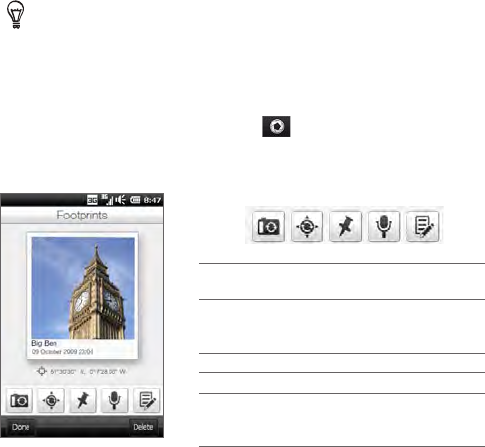
212 Chapter 11 Finding and Recording Places
4. When the GPS position is displayed on the screen, you can now
take a photo of your place of interest.
Before taking a photo, you can:
Change brightness and white balance settings. Tap Menu >
Brightness or White Balance, and choose a setting.
Set Footprints to separately save a large, high-resolution photo.
Tap Menu > Settings and select the Save a large photo in Albums
during capture check box.
•
•
5. Tap the Virtual Camera button ( ) to take the photo.
6. Footprints then displays the captured photo, with several buttons
at the bottom of the screen that allow you to do the following:
54321
1
Retake the photo (if the photo is not
clear enough).
2
Retry GPS positioning (if positioning
is unsuccessful and the GPS location
is not shown).
3
Find the location on Google Maps.
4
Add your voice recording.
5
Edit the footprint to a more
information such as your personal
notes.
7. Tap Done.
The footprint is automatically named with the location name, city, or
country where the photo was taken. If the location, city or country

Chapter 11 Finding and Recording Places 213
cannot be determined, a default name is given. Your footprints are
numbered incrementally as you create more footprints.
Footprints uses a database of cell towers and Wi-Fi hotspots
to estimate your position when naming the footprint and when
determining your location on Google Maps. This database is
continually being improved. If your nearest cell tower or Wi-Fi hotspot
is new to the database, estimation of your position may be inaccurate.
If the footprint name does not reflect your actual location, you can
change and enter your own footprint name. See “Editing a footprint”
for details.
Selecting and saving a photo from Albums as a
footprint
When you select a location’s photo from Albums that is already
geotagged with the GPS position, this information will be added to
the new footprint.
1. On the Home screen, slide to the Photos & Videos tab and then
tap Albums.
2. Tap the photo of the location that you want.
3. While viewing the photo in full screen, tap the screen to display
onscreen controls.
4. Tap Menu ( ) > Set as Footprints.
5. Drag and move the photo to center a small part of the photo on
the crop box.
6. Tap Done to crop the selected part of the photo and save it as a
new footprint.
7. The Edit screen then opens and lets you add location information
to the footprint. See “Editing a footprint” for details.

214 Chapter 11 Finding and Recording Places
Editing a footprint
After creating a footprint, you can edit it to include more information
such as a phone number, street address, website address, your voice
recording, and personal notes.
1. After taking a photo in Footprints, tap the Edit button ( ) to
open the footprint on the Edit screen.
If you selected and saved a photo from Albums as a footprint,
the Edit screen automatically opens the footprint.
On the Home screen’s Footprints tab, you can also tap a footprint
and then tap Menu > Edit to open it.
2. To change the footprint name, enter the new name on the
uppermost text box.
Tap the photo below the footprint name if you want to retake or
select another photo.
3. By default, footprints are all classified as Favorites. To change
the category for your footprint, tap the Favorites box and select
another category such as Shopping, Dining, Leisure, or Others.
4. Tap the boxes to the right of the , and icons to
enter the street address, phone number, and website address
respectively.
If there is no GPS data shown or stored on the footprint, you can
retry GPS positioning and add the GPS data to the footprint by
tapping . You can also enter GPS information manually.
5. Use the recording controls to make a voice recording, replay, or
delete the voice recording.
6. To add your personal notes, enter your text in the text box at the
bottom of the Edit screen.
7. To save your changes, tap Done.
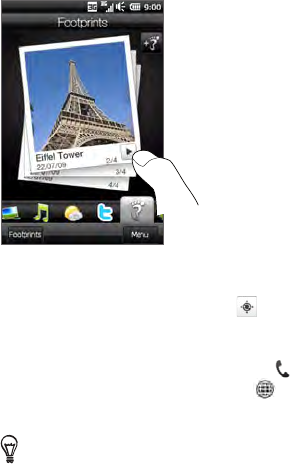
Chapter 11 Finding and Recording Places 215
Browsing your footprints to find a place you visited
On the Home screen, slide to the
Footprints tab and swipe your finger up or
down the screen to flip through the photos
of the places that you visited. If a footprint
contains a voice recording, tap the Play
button to listen to the recording.
You can also browse footprints by
category. Tap Footprints at the bottom of
the screen, and then on the subsequent
screen, slide left or right across the tabs
at the bottom of the screen to browse by
category.
After finding the footprint of the place that you want, tap the footprint
to view the location details. You can visit that place again easily by
tapping the Navigation icon ( ) to get turn-by-turn directions using
your phone’s GPS navigation software, or tap Menu > Show on Map to
find it on Google Maps.
You can also tap the Phone icon ( ) to call the displayed phone
number, or tap the Globe icon ( ) to access the location’s website
and find more information.
If you have geotagged photos taken using another camera, you can copy
them to your phone and use the PhotoNav feature of the CoPilot GPS
navigation software on your phone to navigate to your geotagged photos.
Make sure to copy your geotagged photos to the following folder on your
phone or storage card:
Phone: \My Device\My Documents\My POI
Storage card: \My Device\Storage Card\My Documents\My POI
216 Chapter 11 Finding and Recording Places
Exporting footprints to your storage card
Back up your footprints by exporting them to your storage card.
You can back up all your footprints or back up by category. Separate
backup files for each category will be saved on your storage card.
You can also export a single footprint only.
1. On the Home screen, slide to the Footprints tab.
2. Tap Footprints at the bottom of the screen.
3. You need to be on the appropriate screen to choose what you
want to back up.
To back up all footprints, you need to be on the All footprints
tab.
To back up a category of footprints, slide to the tab of the
category that you want (for example, Dining).
To back up just one footprint, tap the desired footprint first.
4. Tap Menu > Export.
Importing footprints from your storage card
You can import footprints from a backup file on your storage card
back to your phone. You can also share your backup file to other
people who have HTC Footprints on their phone so they can use your
footprints.
1. On the Home screen, slide to the Footprints tab.
2. Tap Footprints at the bottom of the screen.
3. On the All Footprints tab, tap Menu > Import.
If footprints on your phone are the same as the ones on the
backup file, you can choose whether to keep or overwrite the
footprints on your phone.
•
•
•
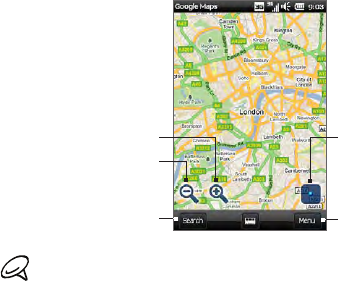
Chapter 11 Finding and Recording Places 217
11.4 Google Maps (Available by Country)
Google Maps tracks your current location through your phone’s
Wi-Fi connection, data connection, or GPS. With Google Maps, you
can search for places of interest or a street address and get detailed
directions to reach your selected destination. You can also easily
locate addresses of your contacts if they are stored on your phone.
To open Google Maps, press START and then tap Google Maps.
Zoom out
Zoom in
Search for
places
View your current
location on the map.
Get directions, join
Google Latitude,
use GPS, and more.
You need an active data or Wi-Fi connection to use Google Maps
Searching a place of interest
Google Maps lets you search and locate a place of interest, shows the
information for that place, and gives directions on how to get there
from your current location.
1. On the Google Maps screen, tap Search.
2. Enter the name, address, or postal code of the place on the
search field and then tap OK.
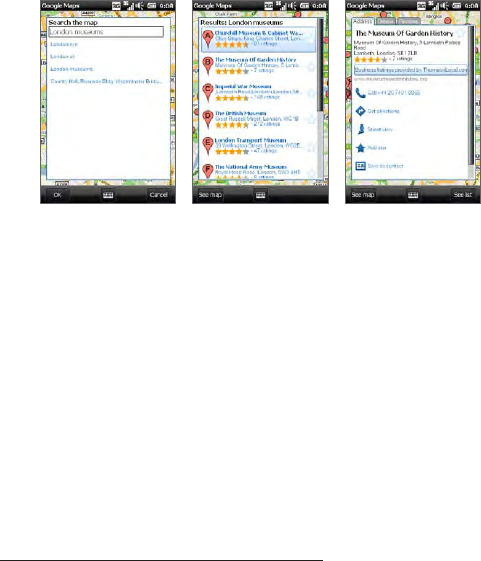
218 Chapter 11 Finding and Recording Places
3. Tap See list to view a list of search results. In the list, tap the
place to view its address, phone number, and other details.
4. On the Address tab, tap:
The [phone number] to call the place of interest.
Get directions to get directions to the place of interest from
your current location.
Street view (available by country) to display a street view of
the place of interest, when available.
Add star to mark the place of interest as a favorite and add it
to your Starred Items list. To access your favorite places, on
the Google Maps screen, tap Menu > Starred Items.
Save as contact to save the contact information of the place
of interest to your contacts list.
Send as text message to send the place’s information to
someone via SMS.
5. Tap See map to view the place of interest on the map.
For more information about Google Maps and its many features, go to:
http://www.google.com/gmm/index.html.
•
•
•
•
•
•

Chapter 11 Finding and Recording Places 219
Using Street View
Street View lets you view interactive street-level images of locations in
Google Maps.
Street View is only available in certain regions.
The images shown in Street View are not in real-time.
•
•
To view a location in Street View
1. On the Google Maps screen, press and hold the location you
want to view in Street View. A box with information about the
location will appear. If Street View is available, a small photo of
the location will appear alongside the information.
2. Tap the information box, and then tap Street view.
You can also access Street View when searching for a place of interest.
For more information, see “Searching a place of interest” in this
chapter.
To navigate a location in Street View
When viewing a location in Street View, a small portion of the map
appears in the bottom right corner of the screen. The person icon on
the map indicates the location of the current Street View image. The
green arrow underneath the person icon points in the direction shown
in the image.
Slide your finger left or right on the screen to pan around the Street
View image. Tap the arrow at the bottom of the screen to move
forward along the current street.

220 Chapter 11 Finding and Recording Places
Using Layers
Layers lets you overlay location-specific information on Google Maps.
You can add multiple layers at a time to create a customized map
containing the specific information you want to view.
To add a layer
1. On the Google Maps screen, tap Menu and then tap Layers.
2. Tap a layer to add it to the map or tap Browse layers, and then
select the layer you want from the list. You can choose from the
following layers:
Layer Description
Traffic Shows real-time traffic data for selected cities.
Satellite Shows aerial satellite imagery of the current map.
Latitude
Shows your friends’ locations on the map and lets you
share your location with them. To see a list of your
friends using Latitude, tap See list. To invite friends to
share location information, tap Add friends. To view a
specific friend’s location on the map, tap your friend in
the list, and then tap See map.
My Maps Shows your custom My Maps created using Google
Maps on your computer. To learn more about My Maps,
go to:
http://maps.google.com/help/maps/mymaps/create.
html.
Wikipedia Shows locations on the map that have associated
Wikipedia articles. Tap the Wikipedia icon marking a
location to view an excerpt of its Wikipedia article. The
excerpt also contains a link to the full article.

Chapter 11 Finding and Recording Places 221
Layer Description
Transit Lines Shows public transportation lines for selected cities.
Favorite
Places
Shows favorite places of local experts from cities
around the world. Tap a favorite place on the map
to view a description of the location written by the
local expert. Tap View full description to view more
information about the location.
You must be logged in to your Google Account to view the My Maps
and Latitude layers. To sign in, on the Google Maps screen tap Menu
and then tap Sign In.
You must join Latitude before you can view the Latitude layer. To
join Latitude, on the Google Maps screen tap Menu and then tap
Join Latitude.
The Latitude, traffic, and transit lines features are available only in
certain regions.
The images shown in the Satellite layer are not in real-time.
•
•
•
•
To remove a layer
1. On the Google Maps screen, tap Menu and then tap Layers.
2. Layers that are currently on are indicated by green check marks.
Tap the layer name or check mark to remove the layer from the
map.
222 Chapter 11 Finding and Recording Places
11.5 Bing
Microsoft Bing™ is a separate program that offers you a fast, easy way
to find and view maps and local information on your phone. With Bing,
you can:
Get up-to-date local information such as movies and gas prices.
Find your location with or without using GPS.
Search places by voice.
Browse listings by category.
Locate nearby restaurants, shopping centers, etc., and check for
their street addresses and phone numbers.
View maps and get directions for reaching a destination.
View traffic information (US only at present).
To open Bing
Press START and then tap Bing.
•
•
•
•
•
•
•

Chapter 12
Camera and Multimedia
12.1 Taking Photos and Videos
Use Camera to take photos and record video clips. The screen
orientation automatically switches to landscape mode when you open
Camera.
On the Home screen, slide to the Photos & Videos tab and then tap
the:
Camera icon ( ) to open the Camera screen in Photo mode
and start taking photos.
Camcorder icon ( ) to open the Camera screen directly to
video mode.
Changing the capture mode
By default, the capture mode is set to either photo or video mode,
depending on what you selected when you opened Camera. Aside
from these, Camera provides other capture modes for different needs.
1. To change to another capture mode, tap to display the
onscreen controls, and then tap the middle icon at the bottom of
the Camera screen.
2. In the Capture Mode menu, tap the capture mode you want
to use.
•
•
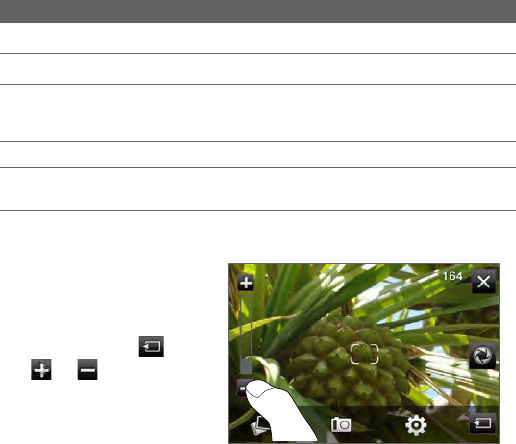
224 Chapter 12 Camera and Multimedia
Capture mode Function
Photo Captures standard still images.
Video Records video clips, with or without audio.
Panorama Captures still images continuously in one direction,
and then stitches them to create a panoramic view of
a scenery.
MMS Video Records video clips suitable for sending via MMS.
Contacts Picture Captures a still image that you can assign as a
contact picture.
Zooming
Before capturing a photo or a
video clip, you can zoom in or
out on your subject using the
onscreen zoom buttons.
To zoom in or out, tap , and
then tap or located above
and below the zoom bar at the
left side of the Camera screen.
The zoom bar shows the current
zoom level.
The camera zoom range for a photo or a video clip depends on the
capture mode and resolution.

Chapter 12 Camera and Multimedia 225
Capture mode Resolution Zoom range
Photo 5M Normal: 2592 x 1944
Widescreen: 2592 x 1728 1.0x to 1.6x
3M Normal: 2048 x 1536
Widescreen: 2048 x 1360 1.0x to 1.6x
2M Normal: 1600 x 1200
Widescreen: 1600 x 1056 1.0x to 1.6x
1M Normal: 1280 x 960
Widescreen: 1280 x 848 1.0x to 1.6x
LNormal: 640 x 480
Widescreen: 640 x 416 1.0x to 1.6x
Video VGA 640 x 480 1.0x to 1.6x
CIF 352 x 288 1.0x to 1.6x
L 320 x 240 1.0x to 1.6x
MMS Video M 176 x 144 1.0x to 1.6x
Panorama L 640 x 480 1.0x to 1.6x
M 320 x 240 1.0x to 1.6x
Contacts
Picture 272 x 272 1.0x to 1.6x
Capturing photos and videos
The camera features two types of focus modes: Auto Focus and
Touch Focus. When using either type of focus mode, the camera is
capable of automatically focusing when you move and point it in
another direction. While the camera is focusing, the screen displays an
animated bracket that changes to a steady, rectangular bracket ( )
when the focus is set.
Use the Virtual Camera button ( ) as the shutter release when
capturing photos or videos. After the camera focuses, press the
Virtual Camera button shortly to capture the photo or video. You can

226 Chapter 12 Camera and Multimedia
also press and hold the Virtual Camera button to refocus and then
capture the photo or video.
To capture a photo or video using Auto Focus
Auto Focus sets the focus on the subject at the center of the screen.
Auto Focus is available for all capture modes.
Press and hold the Virtual Camera button to set the focus and
take a photo.
Press and hold the Virtual Camera button to set the focus and
start capturing a video. Press the button again to stop capturing.
To take a photo using Touch Focus
Touch Focus allows you to focus on a particular area of the screen by
touching it. Touch Focus is enabled by default and is available in the
Photo and Contacts Picture capture modes.
1. Set the capture mode to Photo or Contacts Picture mode.
2. Tap the area on the screen where you want to focus. The focus
indicator positions itself on the selected area.
If you tap outside the effective focus area, a white box appears
to indicate the area where you can use Touch Focus.
3. Press and hold the Virtual Camera button to set the focus and
take a photo. You can also directly press and hold the area you
selected (that is, the area enclosed within the focus indicator) to
focus on that area and take a photo.
To capture photos in Panorama mode
Press and hold the Virtual Camera button to set the focus and capture
the first photo. Press and hold the button again to focus and capture
each subsequent photo and complete the panorama.
•
•
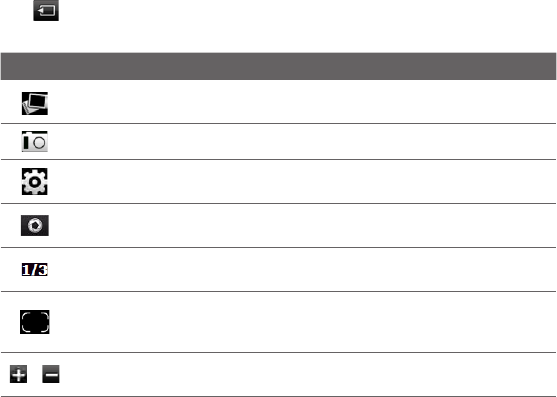
Chapter 12 Camera and Multimedia 227
To select what to do with the captured photo or video
After capturing, the Review screen appears, showing the photo or the
starting frame of the video that you have just captured.
You can tap the icons on the right side of the Review screen to delete
the photo or video clip, view it in Albums, send it by MMS or email,
and more.
Onscreen controls
Tap to display and use the following onscreen controls of the
Camera:
Onscreen control Function
Albums Open the Albums program. See “Viewing Photos
and Videos Using Albums” for details
Capture mode See “Changing the capture mode” for details.
Menu Open the Menu Panel. See “Basic settings” for
details.
Virtual Camera
button
Functions as the shutter release button. See
“Capturing photos and videos” for details.
Progress
indicator
In Panorama mode, this shows the number of
consecutive shots.
Focus
indicator
The screen displays an animated bracket when
focusing that changes to a steady, rectangular
bracket when the focus is set.
/ Zoom buttons Tap to zoom in or out when capturing a photo or
video. See “Zooming” for details.
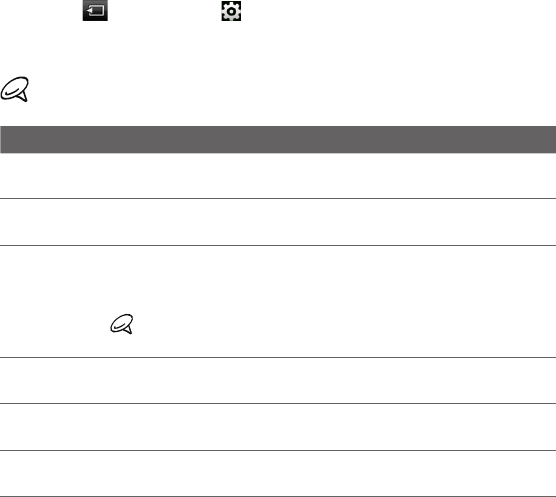
228 Chapter 12 Camera and Multimedia
Basic settings
The Menu panel lets you quickly adjust common camera settings and
provides access to more advanced camera settings. To open the Menu
panel, tap , and then tap . To adjust a setting, keep tapping a
button, for instance, White Balance, to cycle through the available
settings.
The available menu panel buttons depend on the selected capture
mode.
Setting Function
White
Balance
Select the white balance setting according to the current
lighting condition to capture colors more accurately.
Brightness Open the Brightness bar and adjust the brightness level. Tap
outside the Brightness bar to apply the change.
ISO Set the ISO level manually to 100, 200, 400, or 800, or set it
back to AUTO. Higher ISO numbers are better for taking pictures
in low light conditions.
The camera automatically adjusts the ISO level up to 400
only.
Storage Choose between saving your captured photos and videos on
the phone’s storage or the inserted storage card.
Self-timer Set the self-timer to 2 seconds, 10 seconds, or Off when in
Photo or Contacts Picture mode.
Advanced Open the Advanced screen to adjust advanced camera
settings. See “Advanced settings” for details.

Chapter 12 Camera and Multimedia 229
Advanced settings
To open the Advanced screen so you can set more options for your
selected capture mode and set other preferences, tap on the live
Camera screen and then tap Advanced.
On the Advanced screen, you can change the following settings:
Resolution (Photo, Video and Panorama modes). Select the
resolution to use.
Widescreen (Photo mode). When set to On (default), you can
use the entire screen to frame your subject. When Off, a side bar
appears on the right side of the Camera screen that holds the
Virtual Camera and onscreen control buttons.
Touch Focus (Photo and Contacts Picture modes). Enables or
disables the Touch Focus function. Touch Focus is On by default.
For more information about Touch Focus, see “Capturing photos
and videos”.
Review Duration. Set the time for a captured photo/video to
remain on the Review screen.
Quality. Select the image quality level for captured photos.
Capture Format (Video and MMS Video modes). Select the file
format for recorded videos.
Time Stamp (Photo mode). Include the date and time on
captured photos.
Keep Backlight. Turn the backlight on or off. This overrides your
phone’s backlight settings while you are using the camera.
Shutter Sound. Play a shutter sound when you press the Virtual
Camera button.
Image Properties. Adjust the Contrast, Saturation, and Sharpness
before capturing.
•
•
•
•
•
•
•
•
•
•

230 Chapter 12 Camera and Multimedia
Effect. Apply a special effect to your photos or videos.
Metering Mode. Choose how the camera measures the amount of
light in images to calculate exposure values. When Touch Focus
is enabled, the Spot metering mode is set automatically and
the camera measures light around the focus point. When Touch
Focus is disabled, you can select Center Area to measure light in
the center of the image or Average to measure light in the whole
image.
Prefix. The file name of a newly captured photo or video is set to
“IMAG” or “VIDEO” followed by a sequential number, for example:
IMAG0001.jpg. You can also choose the current Date or Date &
Time as the file name prefix.
You cannot change the file name prefix when saving captured
photos to a storage card. Captured photos are named using the
convention IMAGnnnn.jpg (where ‘nnnn’ is the counter), and are
saved to the \DCIM\100MEDIA folder on the storage card.
Counter. Reset the file numbering back to 1.
Flicker Adjustment. When taking indoor shots under fluorescent
lighting, keep this setting on Auto or change it to the proper
frequency (50Hz or 60Hz) of the power in your country to reduce
flicker.
Grid (Photo mode). Show a grid on the screen so you can easily
frame and center your subjects.
Record with Audio (Video and MMS Video modes). Select On to
record videos with audio, or Off to record videos without audio.
Recording Limit (Video mode). Set the maximum duration or file
size for recording video.
Show Reminder (Contacts Picture mode). Select On if you want
the Camera to prompt you to assign the captured picture to a
contact.
•
•
•
•
•
•
•
•
•
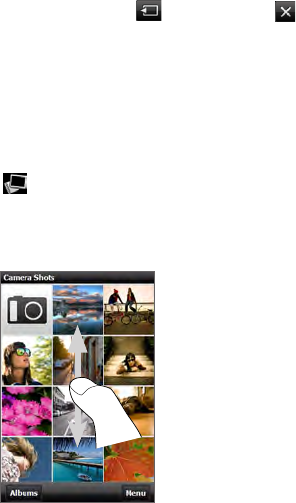
Chapter 12 Camera and Multimedia 231
Direction (Panorama mode). Choose the direction in which to
stitch the photos in a panorama.
Stitch Count (Panorama mode). Select the number of shots to
take and stitch into a panorama.
Closing the Camera
When you are done using the Camera, tap , and then tap to
close the Camera screen.
12.2 Viewing Photos and Videos Using Albums
Use Albums to view photos and videos on your phone. You can also
view photos that you and your friends have shared on Facebook.
On the Home screen, slide to the Photos & Videos tab and then tap
Albums. You can also tap from the Camera screen to open Albums.
On the Albums main screen, swipe your finger up or down to scroll
and browse through photos and videos that are stored on your phone
and storage card. Tap a photo or video to view it in full screen.
•
•
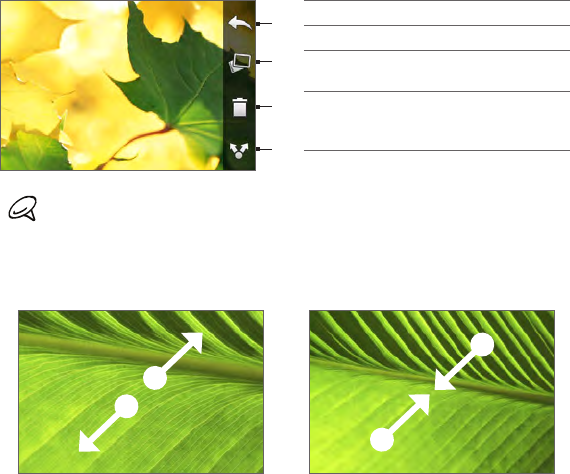
232 Chapter 12 Camera and Multimedia
You can view Albums in portrait or landscape orientation. Turn
your phone sideways to the left to switch the screen to landscape
orientation.
Viewing photos
While viewing a photo, tap the screen to display and use onscreen
controls.
1Return to the previous screen.
2Start the slideshow.
3Send the photo using email or
MMS, or upload it to Facebook.
4Save the photo as a contact
picture, save the onscreen image
as a new file, and more.
1
2
3
4
When playing a slideshow, animated GIF and video files are excluded
from the slideshow.
To zoom in or out on a photo
Press your thumb and index finger on the screen and then spread your
fingers apart to zoom in. Pinch your fingers together to zoom out.
Zooming in Zooming out

Chapter 12 Camera and Multimedia 233
You can also double-tap the area on the photo you want to zoom in
on. To zoom out, double-tap the screen again.
After zooming in on a photo, press and hold the screen and then drag
your finger to pan to other areas of the photo.
To save the zoomed in part of the photo as a new file, tap the screen, tap
and then select Save Screen Image.
To view the next or previous photo in the current album
While holding your phone upright, view the next or previous photo by
swiping your finger up or down the screen.
While holding your phone sideways, view the next or previous photo
by swiping your finger left or right across the screen.
To set a favorite album
The Photos & Videos tab on the Home screen displays photos and
video files from the current favorite album. By default, the Camera
Shots album which stores the photos and videos you captured using
the Camera is set as the favorite album. You can change to another
favorite album, if preferred.
1. On the Albums main screen, tap Albums.
2. On the Albums tab ( ), tap the album you want to set as your
favorite.
3. Tap Menu > Set Album as Favorite, and then tap OK.

234 Chapter 12 Camera and Multimedia
Viewing Facebook photos
You can use Albums to view photos you and your friends have shared
on Facebook. You must be logged in to your Facebook account to be
able to view Facebook photos.
1. On the Albums main screen, tap Albums.
2. Tap or slide to the Facebook tab ( ).
If you have not logged in to Facebook, the subsequent screen
lets you log in to your Facebook account.
3. Tap the person whose photos you want to view, and then tap an
album.
4. Tap a photo to display it in full screen.
While viewing a photo, tap the screen to display and use the onscreen
controls.
Onscreen
control
Function
Return to the previous screen.
Send the photo using email or MMS.
Reload the current photo.
Playing videos
While watching a video, tap the screen to display and use playback
controls. Tap the playback control icons to pause, resume, stop
playback, jump to the start of the video, or switch the display mode.
You can also drag your finger across the progress bar to go forward or
backward in the video.

Chapter 12 Camera and Multimedia 235
When you’ve finished or stopped playing the video, you can replay the
video by tapping the Play icon on the center screen.
You can also send this video by email or MMS or share it on
YouTube. Tap the screen, tap the Share icon ( ), and then
choose how you want to share the video.
Sharing photos and videos
Using Albums, you can send photos and videos via email and MMS,
upload photos to Facebook, and upload videos to YouTube. You must
be logged in to Facebook and YouTube to upload photos and videos
to those sites.
1. Open the album containing the photos or videos you want to
share.
2. Tap Menu > Share, and then choose one of the following:
Mail. Tap one or more photos or videos you want to add as
email attachments and then tap Send. If you have more than
one email account, select the account to use. Compose your
message and then tap Send. For more information about
sending email, see Chapter 7.
Messages. Tap a photo or video to add it to a new multimedia
message. Compose your message and then tap Send. For more
information about sending multimedia messages, see Chapter 7.
Facebook. Tap one or more photos you want to share and
then tap Upload.
YouTube. Tap one or more videos you want to share and
then tap Next. Enter a Title and Tags for your videos, select a
privacy setting, and then tap Upload.
•
•
•
•
236 Chapter 12 Camera and Multimedia
12.3 Using Windows Media Player Mobile
Windows Media Player Mobile plays digital audio and video files that
are stored on your phone or on the Web.
To open Windows Media Player Mobile, press START and then tap
Multimedia > Windows Media. Windows Media Player Mobile opens
with the Library screen. Use the Library screen to find and play songs,
videos, and playlists that are stored on your phone or on the storage
card.
Playing media
To update the Library
In most cases, Windows Media Player Mobile automatically updates
the library. However, you can manually update the library to ensure
that it contains new files that you recently copied to your phone or to
the storage card. Tap Menu > Update Library to manually update the
library list.
To play audio and video files
1. On the Library screen, tap the Library arrow (near the top of the
screen), and then tap the media storage that you want to use, for
example, Storage Card.
2. Select a category (for example, My Music or My Playlists).
3. Press and hold the item that you want to play (such as a song,
album, or artist name), and then tap Play.
The Playback screen opens and plays the audio or video file. Use
the playback controls to pause, resume, stop playback, play in full
screen, and more.

Chapter 12 Camera and Multimedia 237
Synchronizing video and audio files
Use the latest version of Windows Media Player on your computer
to sync digital media files from your computer to your phone. This
ensures that protected files and album art (for skins) are correctly
copied to your phone.
To automatically sync content to your phone
1. On your computer, open Windows Media Player, and then
connect your phone to your computer.
2. In the Device Setup Wizard, select Yes, search my computer now.
If you have previously opened Windows Media Player and
searched for media on your computer, you are not prompted to
search your computer in step 2.
3. On the Device Setup dialog box, enter a name for your phone
and click Finish.
If you installed a storage card that has a capacity of more
than 4GB and your entire library can fit into the storage card,
Windows Media Player will automatically sync your music
files. Your phone also needs to be set to Disk Drive mode for
Windows Media Player to automatically sync.
4. On the left panel of Windows Media Player, right-click the name
of your phone and click Set Up Sync.
To set up media synchronization on a storage card, right-click
Storage Card in the left panel of Windows Media Player, and then
click Set Up Sync.
5. Select the playlist(s) that you want to sync between your
computer and phone, and then click Add.
On the Device Setup dialog box, make sure that the Sync this
device automatically check box is selected.
6. Click Finish.
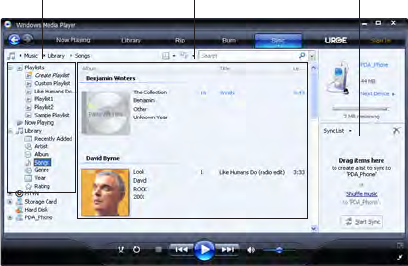
238 Chapter 12 Camera and Multimedia
The files begin synchronizing to your phone. The next time you
connect your phone to your computer while Windows Media Player is
running, synchronization will start automatically.
To manually sync content to your phone
1. If you have not set up media synchronization between your
phone and computer, follow steps 1 to 3 in “To automatically sync
content to your phone”.
2. Click the Sync tab on the Windows Media Player of your
computer. Select a Playlist or a Library on the left panel of the
Windows Media Player.
3. From the Content List, drag the media files that you want to sync
to your phone and drop them to the Sync List.
Playlists and Library List Sync ListContent List
4. Click Start Sync to start synchronizing the selected files to your
phone.

Chapter 12 Camera and Multimedia 239
Use Windows Media Player 11 or higher on your computer to sync
media files to your phone.
Audio files copy faster if Windows Media Player is configured to
automatically set the quality level for audio files copied to your
phone. For more information, see the Windows Media Player Help.
•
•
Creating playlists
Create a new playlist by saving the current Now Playing playlist and
giving it a new name.
To save a new playlist
1. If you are not on the Library screen, tap Menu > Library.
2. Tap to select a category (for example, My Music or My Playlists).
3. Select a media file that you want, then tap Menu > Queue Up.
This adds the file to the Now Playing list. Repeat this step until
you have added all desired media files to the Now Playing list.
You cannot select multiple files simultaneously.
4. After adding the media files, tap Menu > Now Playing.
5. On the Now Playing screen, tap Menu > Save Playlist.
6. Enter the playlist name, then tap Done.
7. To play back the playlist you created, tap My Playlists in the
Library, select your playlist, then tap Play.
Troubleshooting
For troubleshooting information, visit http://www.microsoft.com/
windowsmobile/en-us/help/more/windows-media-player.mspx.
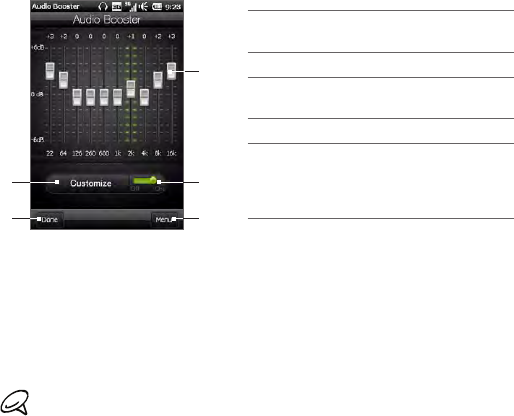
240 Chapter 12 Camera and Multimedia
12.4 Using Audio Booster
Audio Booster optimizes sound by providing an audio equalizer for a
better listening experience. To use Audio Booster, connect the supplied
wired headset to your phone.
To open Audio Booster
Press START and then tap Multimedia > Audio Booster, or from the
Home screen, slide to the Music tab and then tap Menu > Audio
Booster.
1Choose the equalizer preset to
use.
2Apply the modified settings.
3Drag the sliders to adjust the
frequency.
4Enable or disable the equalizer.
5Exit Audio Booster without
applying the modified settings,
or save or delete preset equalizer
settings.
1
52
4
3
To create a custom equalizer preset
1. Adjust the frequency bands to your desired values by dragging
the equalizer controls.
2. When finished, tap Menu > Save as Preset.
3. Enter a preset name and then tap Done. The equalizer preset is
added to the preset list box.
To delete a custom equalizer preset, select it on the preset list box
and then tap Menu > Delete Preset. You cannot delete pre-installed
equalizer presets.
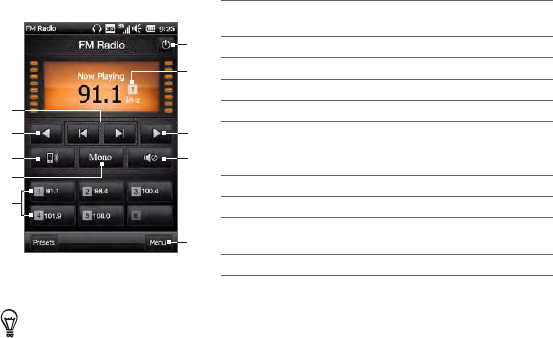
Chapter 12 Camera and Multimedia 241
12.5 Using FM Radio
FM Radio lets you to listen to FM radio stations on your phone. Since
FM Radio uses the provided stereo wired headset as the antenna,
connect the headset first to the earphone jack of your phone before
you open the program.
To open FM Radio, press START and then tap Multimedia > FM Radio.
The first time you open FM Radio, it automatically scans for available
FM stations, saves them as presets, and plays the first FM station
found. For information about saving favorite stations as presets, see
“Saving presets.”
1
Search the FM band for the next lower or
higher FM station.
2
Fine tune the radio frequency by -0.1 MHz.
3
Select headset or speaker audio output.
4
Select mono or stereo audio.
5
Preset FM stations. Tap a station to tune in.
6
Set FM Radio options, such as Scan and
Save, mute the audio, and select the audio
output.
7
Turn the sound on or off.
8
Fine tune the radio frequency by +0.1 MHz.
9
Station preset number (if you saved the
station as preset)
10
Turn off FM radio.
10
9
1
8
7
6
4
5
3
2
Press the VOLUME UP and VOLUME DOWN buttons on the side of the
phone to adjust the volume.

242 Chapter 12 Camera and Multimedia
Saving presets
Save favorite FM stations as presets so you can easily access them.
You can save up to 20 preset radio stations. Radio stations that are
saved on Presets 1 to 6 can be accessed on the FM Radio screen.
To save FM stations as presets
1. Tune in to the desired FM frequency, and then tap Presets.
2. On the Presets list, tap that appears on the desired preset
number where you want to save the FM station.
Tap to remove a favorite FM station from the list.
3. When finished, tap Done.
To listen to a preset FM station
On the FM Radio screen, tap the station preset button. If the station
preset button is not on the screen, tap Presets, scroll through the list
of preset stations, and then tap the station you want to listen to.
Minimizing or turning off FM Radio
When you leave the FM Radio screen, FM Radio continues to run in
the background and allows you to continue listening to the radio while
you use other programs. To turn off FM radio, tap on the upper
right corner of the FM Radio screen.
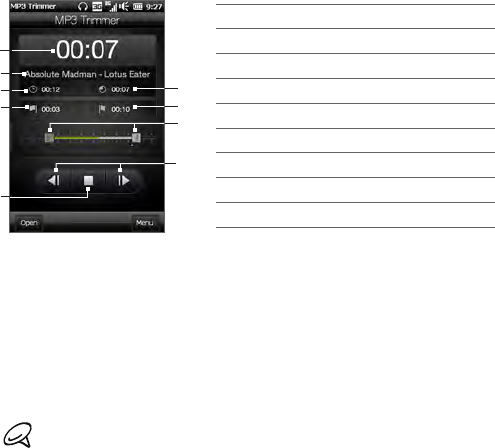
Chapter 12 Camera and Multimedia 243
12.6 Using MP3 Trimmer
Use MP3 Trimmer to trim an MP3 file and save it as a new file or set it
as a ringtone.
1Playback time
2Title
3Duration of original MP3 file
4Start point
5Play/Stop
6Duration of trimmed MP3 file
7End point
8Start point and end point sliders
9Backward or foreward controls
2
3
1
5
9
8
6
47
To trim an MP3 file
1. Press START and then tap Multimedia > MP3 Trimmer.
2. Tap Open to locate and select the MP3 file you want to trim.
3. On the progress bar, drag the start point slider right to the
desired start time and the end point slider left to the desired end
time. You can also tap the slider you want to adjust to select it,
and then tap the backward or foreward controls at the bottom of
the screen to precisely adjust the start and end times.
After you set the start point, the MP3 file plays from the start
point. After you set the end point, the MP3 file plays from 3
seconds before the end point.
4. Tap Play to play the trimmed file.
5. Tap Menu and select whether to set the file as the default
ringtone, save the file to the ringtone folder, or save it as another
file name.

Chapter 13
Other Programs
13.1 Calculator
Calculator features basic calculation functions, and also works as an
advanced scientific calculator.
Basic Calculator
Use the Basic Calculator to do basic arithmetic such as addition,
subtraction, multiplication, and division. You can also work with
numbers you store in the calculator memory.
1. Press START and then tap Tools > Calculator.
2. Operate the calculator the same as you would a handheld
calculator by tapping the onscreen keys to enter numbers, clear
the entered number, and perform calculations.
3. You can also tap the respective buttons on the left side of the
screen to add values to the calculator memory, display the stored
number from the calculator memory, or clear the calculator
memory.
A maximum of 9 digits can be entered for each number.
Tap Copy at the lower-left side of the screen to copy the displayed
value so that you can paste it to another program that has a paste
function, such as Notes.
The Basic Calculator can only be used when the screen display is in
portrait mode.
•
•
•
Chapter 13 Other Programs 245
Scientific Calculator
Use the Scientific Calculator to perform more complex calculations
such as square roots, logarithmic and trigonometric functions,
percentages.
1. Press START and then tap Tools > Calculator.
2. Turn your phone sideways to the left to display the Scientific
Calculator.
3. Tap the Rad/Deg button to toggle between degrees or radian
measurement.
4. Tap the FN button to display the second layer of scientific
calculation buttons.
5. When you tap one of these function buttons after entering a
number, the corresponding operand or operator is displayed. You
can continue to enter numbers, operands and operators to build
the formula expression.
6. Tap the = button to compute and display the calculation result.
246 Chapter 13 Other Programs
13.2 Microsoft Office Mobile
Microsoft® Office Mobile consists of the following applications:
Microsoft® Office Excel® Mobile lets you create and edit Excel
workbooks and templates on your phone.
Microsoft Office OneNote Mobile lets you create notes with
text, photos, and voice recordings for synchronization later with
Microsoft Office OneNote 2007 on your computer.
Microsoft® Office PowerPoint® Mobile allows you to view (not
create) slide show presentations in *.ppt and *.pps formats.
Microsoft® Office Word Mobile lets you create and edit
documents and templates in Word Mobile and save them as
*.doc, *.rtf, *.txt, and *.dot files.
To use Microsoft Office Mobile
1. Press START and then tap Office Mobile.
2. Tap the Office Mobile application that you want to use.
Word Mobile and Excel Mobile do not fully support some features of
Microsoft Office Word and Microsoft Office Excel. To find out which
features are not supported, press START, tap Help and then search for
“unsupported” in the Help.
•
•
•
•

Chapter 13 Other Programs 247
By default, Word Mobile saves documents in .docx format, while Excel
Mobile saves workbooks in .xlsx format. If you want to open these
types of files on a computer that uses Microsoft Office 2000, Office
XP, or Office 2003, you need to download and install the File Format
Converter in your computer. Download the File Format Converter at
http://www.microsoft.com/downloads/.
If you want Word Mobile to save documents in .doc format, tap Menu >
Tools > Options (or Menu > Options when no document is opened),
and then change the Default template to Word 97-2003 Document
(.doc).
If you want Excel Mobile to save workbooks in a format that is
compatible with Microsoft Office 2000, Office XP, or Office 2003, tap
Menu > Options (with no workbook opened), and then change the
Template for new workbook to Blank 97-2003 Workbook.
•
•
•

248 Chapter 13 Other Programs
13.3 WorldCard Mobile
WorldCard Mobile lets you take a photo of a business card and easily
export the contact information on the card into your Contacts.
To capture a business card and export its information to Contacts
1. Press START and then tap Tools > WorldCard Mobile.
2. Tap on the WorldCard Mobile screen to open the Camera
program.
3. Tap the Virtual Camera button ( ) to take a photo of the
business card, then tap the Back button ( ) on the Review
screen. Refer to Chapter 12 for details on how to use the camera.
Make sure that the business card is displayed completely on the
Camera screen before you take the photo, and that lighting is
adequate.
4. On the WorldCard Mobile screen, tap Recognize.
If you want to retake the shot, tap Re-Capture.
For better recognition, choose the language and region based on
the language used in the business card.
•
•
5. The screen shows various contact information from the business
card. Edit the contact information, if needed. Clear the check
boxes of items that you do not want to be exported.
6. Tap Export, then go to your Contacts list to view the exported
contact.
For more information about using WorldCard Mobile, tap on the
WorldCard Mobile screen to view the program help.
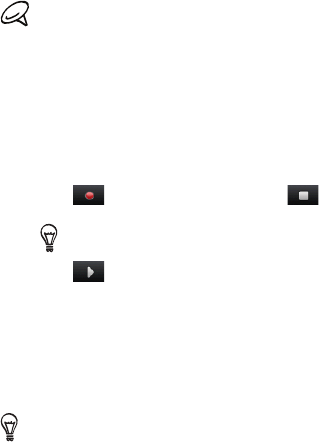
Chapter 13 Other Programs 249
13.4 Voice Recorder
Quickly capture voice notes, reminders or any important moment
with Voice Recorder. You can also send a voice recording as a
multimedia message or email attachment, beam it to another device
via Bluetooth, or set it as your ringtone.
Voice Recorder saves voice recordings in AMR-NB (Adaptive Multi-
Rate Narrowband) format only. This is a common speech audio
format used in mobile devices.
Voice recordings are saved in the My Recordings folder on your
phone. If you inserted a storage card in your phone, voice recordings
are saved in the My Recordings folder on the storage card,
•
•
To create and play a voice recording
1. Press START and then tap Tools > Voice Recorder.
2. Hold the phone’s microphone close to the sound source.
3. Tap to start recording. Tap to end the recording.
You can also tap Add recording on the All Recordings screen to
create a new voice recording.
4. Tap to play back the voice recording.
5. To control playback:
Use the onscreen controls to stop or pause playback.
Drag your finger right or left on the progress bar in the middle
of the screen to move forward or backward in the voice
recording.
You can leave the Voice Recorder screen while a recording is in progress
and the recording will continue in the background. The recording status
and time is shown on the notifications screen. Tap the notification to
return to the Voice Recorder screen.
•
•

250 Chapter 13 Other Programs
To open and play a saved voice recording
1. On the Voice Recorder screen, tap All Recordings.
2. Tap a file to open it and begin playback.
To send a voice recording
1. Open the voice recording you want to send.
2. On the Voice Recorder screen, tap Share, and then choose a send
option:
Send via Bluetooth. If prompted to turn on Bluetooth, tap
Yes. Select a device to send the voice recording to. For more
information about using Bluetooth, see Chapter 10.
Send via Mail. If prompted, select the email account you want
to use to send the voice recording. The voice recording is
added as an attachment to a new email. Compose your email
and tap Send. For more information about sending email, see
Chapter 7.
Send via MMS. The voice recording is added as an attachment
to a new multimedia message. Compose your message and
tap Send. For more information about sending multimedia
messages, see Chapter 7.
Send to Event Attendees. Choose a calendar event with
attendees you want to send the voice recording to. The voice
recording is added as an attachment to a new email with the
event attendees added as recipients. Compose your email and
tap Send.
To send a voice recording to event attendees, the attendees
must be included in the meeting request for the event, and the
event must be on the date of the voice recording or within the
previous or next three days.
•
•
•
•

Chapter 13 Other Programs 251
To set a recording as your ringtone
1. Open the voice recording you want to set as your ringtone.
2. Tap All Recordings, and then tap Menu > Set As Ringtone.
3. Tap OK.
13.5 SIM Manager
SIM Manager allows you to view the contents of your SIM card,
transfer contacts from your SIM card to your phone or vice versa, and
make a call to a SIM contact.
To create a contact on your SIM card
1. Press START and then tap Calls > SIM Manager.
2. Tap New and enter the contact name, phone number and email
address.
3. Tap Done.
To change contact information on your SIM card, tap a SIM contact, edit
the information, and then tap Done.
To copy SIM contacts to your phone
If you have saved contacts on your SIM card, you can copy them into
Contacts on your phone.
1. On the SIM Manager screen, select the desired contact, or select
all SIM contacts by tapping Menu > Select All.
2. Tap Menu > Save to Contacts.
252 Chapter 13 Other Programs
To copy contacts to the SIM card
Only one phone number per contact name can be stored on a SIM
card.
1. On the SIM Manager screen, tap Menu > Contacts to SIM.
2. Select the check boxes of the contact’s phone numbers that you
want to copy to your SIM card, and then tap Done.
When you copy a contact that has several phone numbers to your SIM
card, SIM Manager separately saves each number by appending an
indicator at the end of each name.
By default, /M, /W, and /H are appended to indicate mobile, work, and
home phone numbers respectively. To edit the default indicators and
to select which other types of numbers to save to the SIM card, tap
Menu > Tools > Options.
13.6 JBlend
Use JBlend to download, install and manage MIDlets or MIDlet suites
on your phone. MIDlets are Java applications such as games and tools
that can run on mobile devices, while a MIDlet suite is a collection
of one or more MIDlets. Your phone supports Java 2 Micro Edition
(J2ME).
To open JBlend
Press START and then tap Tools > JBlend.
Installing and launching MIDlets/MIDlet suites
To download and install from the Internet
1. Open the Web browser on your phone.
2. Navigate to the Web page with the link for the MIDlet/MIDlet
suite you want to download, and tap the link.

Chapter 13 Other Programs 253
3. Follow the onscreen instructions to install and run the MIDlet/
MIDlet suite.
To install from your phone
You can copy MIDlets/MIDlet suites from your computer to your
phone using the USB sync cable or Bluetooth connection.
1. On the JBlend screen, tap Install > Local Install. The program
then searches for MIDlets/MIDlet suites on your phone and
displays them in a list.
2. From the list, tap the MIDlet/MIDlet suite that you want to install.
3. Follow the onscreen instructions to install and run the MIDlet/
MIDlet suite.
To run a MIDlet/MIDlet suite
On the JBlend screen, open the folder that contains the MIDlet/MIDlet
suite, and then tap the MIDlet/MIDlet suite.
To uninstall a MIDlet/MIDlet suite
Before you uninstall a MIDlet, make sure that it is not running.
1. On the JBlend screen, press and hold the MIDlet, and then tap
Delete.
2. Tap Yes to confirm.
To uninstall all MIDlets and folders, tap Menu > Application > Delete
All.

254 Chapter 13 Other Programs
13.7 Installing and Uninstalling Programs
You can install or uninstall additional programs. Your phone does not
allow you to uninstall most of the preinstalled programs.
Before you purchase additional programs, make sure that they are
compatible with your phone.
Before you launch the program installer, check first whether the
installer can directly run on Windows Mobile or needs to be run on a
computer.
To install a program directly on your phone
1. If the installer is a .cab file, directly download or copy it to your
phone.
2. On your phone, press START, tap File Explorer and then navigate
to the installer file.
3. Tap the file to launch the installer.
4. Choose whether to install the program into the main memory or
your storage card, if you have the storage card inserted on your
phone.
5. Wait for the installation to complete.
You may be prompted to restart your phone after installation is
completed.
To install a program from your computer
1. If the installer is an .exe file such as Setup.exe, most likely, the
installer needs to be run on a computer. Download or copy it to
your computer.
2. Connect your phone to your computer using the USB cable, and
then double-click the installer file on your computer to launch the
installer.
Chapter 13 Other Programs 255
3. Follow the onscreen instructions on your computer and your
phone to complete the installation.
To uninstall a program
1. On the Home screen, slide to the Settings tab.
2. Tap Application > Remove programs.
3. In the Programs in storage memory list, select the program you
want to remove, and then tap Remove.

Chapter 14
Managing Your Phone
14.1 Copying and Managing Files
Copy files between your phone and computer, or copy files to a
storage card installed on your phone. You can also efficiently manage
your files and folders using File Explorer.
To copy files using Windows Mobile Device Center or ActiveSync
1. Connect your phone to the computer.
2. Click File Management > Browse the contents of your device
in Windows Mobile Device Center on your computer, or click
Explore in ActiveSync on your computer. This displays the
content of your phone in Windows Explorer on your computer.
3. To copy a file from your phone to your computer:
a. Browse the contents of your phone, right-click the file you
want to copy, and then click Copy.
b. Right-click a folder on your computer, and then click Paste.
4. To copy a file from your computer to your phone:
a. Browse the folders on your computer, right-click the file you
want to copy, and then click Copy.
b. Right-click a folder on your phone, and then click Paste.
Chapter 14 Managing Your Phone 257
To manage files on your phone using File Explorer
File Explorer lets you browse and manage the contents of your phone.
The root folder on the phone is named My Device, and contains the
following folders: My Documents, Program Files, Windows, and more.
1. Press START and then tap File Explorer.
2. Tap a folder or file to open it.
3. To return to an upper level folder, tap Up.
4. To quickly delete, rename, or copy a file, press and hold the file,
and then choose the desired operation on the shortcut menu. To
copy or delete multiple files, tap and drag over the desired files,
press and hold the selection, and then choose an option from the
menu.
To copy files to a storage card
1. Make sure that the storage card is properly installed on your
phone.
2. Connect the phone to your computer using the USB cable, select
Disk Drive on the Connect to PC screen, and then tap Done.
3. On your computer, navigate to the removable disk drive, and then
start copying files to the storage card.
4. When finished, disconnect the phone from your computer.

258 Chapter 14 Managing Your Phone
14.2 Settings on Your Phone
To access your phone’s settings, press the HOME button to return to
the Home screen and then slide to the Settings tab. The tables below
describe the settings that you will find on the Settings tab.
On the Home screen’s Settings tab, tap Menu > All Settings to access
more settings.
Personalize
Setting Description
Home tab
wallpaper
Select a wallpaper for the Home tab.
Lock screen
wallpaper
Select a wallpaper for the Lock screen.
Home screen tabs Rearrange or hide Home screen tabs.
Font Adjust the screen font size to improve readability in
some applications.
Vibration Choose whether to allow your phone to vibrate when
you tap buttons on certain screens, such as tabs on
the Home screen, Phone dialer’s keypad, onscreen
keyboard, and more.
Wireless controls
Easily manage and turn on or off connections, including the phone
connection, GPRS/3G, Wi-Fi, Bluetooth, and more. (See “Using the
Comm Manager” in this chapter for details.)

Chapter 14 Managing Your Phone 259
Sound & Display
Setting Description
Profiles Choose a profile to automatically set your phone with
the proper volume level that suits your environment.
Volume Set a single volume for the ringer and your phone, or
separately set their volume.
Ring and
Notifications
Choose a ringtone and ring type, set different
notification sounds for different events such as
reminders, new messages, and more.
You can also turn on or off the Quiet ring on pickup
and Pocket mode features.
Display Turn on the auto brightness feature, or manually set
the screen brightness. You can also change the timeout
period for dimming the backlight and turning off
the display (switching the phone to Sleep mode) to
conserve battery power.
G-Sensor Recalibrate the G-Sensor of the phone. Do this when
screen auto rotation is not working properly.
Data services
Setting Description
ActiveSync Set your phone to auto sync your Outlook work email
and other information as they arrive in your Exchange
Server inbox (Direct Push feature), or set a sync
schedule. You can also change the information types to
sync and start synchronization manually.
Utilities Set auto download settings for stocks and weather.
You can also enable or disable the option for
synchronizing your phone with Internet time.

260 Chapter 14 Managing Your Phone
Setting Description
Social Networks Log in or out of your social network accounts such as
Facebook, Twitter, and YouTube. You can also change
the data sync settings for your Facebook and Twitter
accounts.
E-Mail Set the sync schedule for the Internet email accounts
that you have set up on your phone.
Location
Setting Description
Location Service You can enable or disable location service for HTC
applications on your phone. When turned on, your
current location can easily be determined and used to
provide you with accurate information, such as weather
in you current location. You can also choose if you
want to share anonymous location data with Google.
Download
satellites
Set the options for downloading GPS satellite location
data. See “Downloading Satellite Location Data” in
Chapter 11 for details.
Security
Setting Description
Encryption Encrypt files on your storage card. Encrypted files are
only readable on your phone.
Certificates See information about certificates that are installed on
your phone.
Phone lock Set a password for your phone.
Factory reset Reset your phone to factory default settings.

Chapter 14 Managing Your Phone 261
Application
Setting Description
Remove programs Uninstall programs that you previously installed on
your phone.
Managed
programs
Displays the programs that were installed on your
phone using System Center Mobile Device Manager.
SD card & phone storage
Check the storage space and usage information of your phone and
storage card.
Date & time
Set local time settings and time format.
Locale & text
Setting Description
Regional Set the regional configuration to use, including the
format for displaying numbers, currency, date, and time
on your phone.
Text input Set the keyboard type to use for text input, select
keyboard languages, and turn on or off input features
such as symbol lock, typing sound, and QWERTY
keyboard text prediction. You can also delete words
from the user dictionary and view a basic tutorial on
entering text with the onscreen keyboard.

262 Chapter 14 Managing Your Phone
Updates & feedback
Setting Description
Customer
feedback
Set your phone to automatically send information
about how you use Windows Mobile. By default, this
option is disabled.
Error reporting Enable or disable the phone's error reporting function.
When this function is enabled and a program
error occurs, technical data about the state of the
program and your computer is logged in a text file
and delivered to Microsoft's technical support if you
choose to send it.
Other
Setting Description
Location Service You can enable or disable location service for HTC
applications on your phone. When turned on, your
current location can easily be determined and used to
provide you with accurate information, such as weather
in you current location.
You can choose if you want to share anonymous
location data with Google.
Uploader Shows the upload progress when you are uploading
photos or videos to social networks. Tap History to see
what photos or videos you have previously uploaded.
USB to PC Set the type of USB connection to your PC. Select the
ActiveSync option for synchronizing data, Disk Drive
mode for transferring files, or Internet Sharing to use
your phone as a modem for your computer.
Wi-Fi Turn the Wi-Fi function on or off, scan for available
wireless networks, see information about the active
wireless network, and customize Wi-Fi settings.

Chapter 14 Managing Your Phone 263
About phone
Setting Description
Phone identity Specify a name to be used for identifying the phone to
other devices. You can also see basic information such
as the model number, IMEI, and serial number of your
phone.
Hardware
information
Shows phone specifications such as processor type
and speed, storage size, display resolution, and more.
Software
information
Shows information such as the Windows Mobile
version, ROM version, duration of calls, and more.
Battery Check the remaining battery power. There is also an
option that allows you to enable or disable charging
your phone’s battery when the phone is connected to
your computer.
About Shows copyright information.
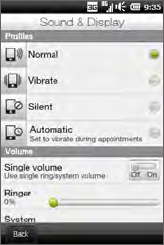
264 Chapter 14 Managing Your Phone
14.3 Basic Settings
Choose settings for your phone that best suit your needs.
Changing sound and display settings
From the Sound & Display screen, you can
choose sound settings for your phone, such
as profile, ringtone, volume level, and different
notification sounds. You can also adjust screen
brightness.
To select a phone profile
A profile is a preset that determines how your phone will alert you
when you have incoming calls. Each profile is preconfigured with a
sound setting that suits your situation. For instance, Silent mutes the
ringtone and is ideal for use when you’re in a meeting. Automatic
sets your phone to vibrate only when you receive phone calls during
scheduled appointments in your Calendar.
On the Home screen, slide to the Settings tab, tap Sound & Display,
and then select a profile that suits your current situation.

Chapter 14 Managing Your Phone 265
To change the ringtone and ring type
1. On the Home screen, slide to the Settings tab and then tap
Sound & Display.
2. Scroll down to the Ring and Notifications settings.
3. Tap Ringtone. Select the ringtone you want to use and then tap
Done.
4. Tap Ring type. Select the ring type you want to use and then tap
Done.
You can use sound files that you downloaded from the Internet or
copied from your computer. For a complete list of supported audio file
formats, see “Specifications” in the Appendix.
To use your sound files as ringtones, copy them first to the
/My Documents/My Ringtones folder on your phone, and then select
the sound from the Ringtones list of your phone. For more information
about copying files, see “Copying and Managing Files” in this chapter.
•
•
To set and adjust a single ring and system volume
1. On the Home screen, slide to the Settings tab and then tap
Sound & Display.
2. Turn on the Single volume setting by tapping its Off/On switch.
3. Drag your finger across the Ringer or System slider to adjust the
volume. As you adjust one volume slider, the other moves along
with it.
Another way is to press the VOLUME UP/DOWN button on the
left panel of your phone to open the Volume screen. To increase
or decrease the volume level, drag your finger up or down the
volume bars, or press the VOLUME UP/DOWN button. You can
also:
Tap Silent to mute the volume.
Tap Vibrate to switch the phone to Vibrate mode.
•
•
266 Chapter 14 Managing Your Phone
To set notification sounds
You can personalize your phone with unique notification sounds for
different events such as missed calls, new text messages, new email,
reminders, and more. On the Home screen, slide to the Settings tab
and then tap Sound & Display > Notification sounds to choose a
different sound for each type of event.
On the Notification Sound screen, tap the left side of the screen
that shows the types of events to choose the sound to use for each
event. Tapping the Off/On switches on the right turns on or off the
notification sounds.
To adjust screen brightness
By default, your phone automatically adjusts the screen brightness
according to the ambient lighting. Turn off auto brightness if you want
to be able to adjust the screen brightness.
1. On the Home screen, slide to the Settings tab and then tap
Sound & Display.
2. Scroll down to the Display setting and then tap Backlight.
3. Clear the Automatically adjust backlight check box.
4. Adjust the brightness by dragging the slider under On battery
power and On external power.
5. Tap Done.
To change backlight and automatic Sleep mode settings
Dimming the backlight and switching the phone to Sleep mode help
save battery power. You can change the idle time before the backlight
automatically dims. You can also change the idle time before the
phone goes into Sleep mode.
1. On the Home screen, slide to the Settings tab and then tap
Sound & Display.
2. Scroll down to the Display setting and then tap Backlight.

Chapter 14 Managing Your Phone 267
3. Under the On Battery Power and On External Power group of
settings, do the following:
Make sure the Dim backlight if device is not used for option is
selected. Tap the box below this option to select a backlight
timeout duration.
Make sure the Turn off device if not used for option is
selected. Tap the box below this option to select a sleep mode
timeout period.
4. Tap Done.
If you do not want the backlight to dim, clear the Dim backlight if device
is not used for check boxes. To turn off automatic Sleep mode, clear the
Turn off device if not used for check boxes.
Specifying a phone name
Specify a name to use for identifying your phone to other devices,
for instance, when synchronizing with a computer, connecting to a
network, or restoring information from a backup.
If you sync multiple phones with the same computer, each phone must
have a unique name.
1. On the Home screen, slide to the Settings tab and then tap
About phone > Phone identity.
2. Enter a phone name and then tap Done.
The phone name must begin with a letter, consist of letters from A to Z,
numbers from 0 to 9, and cannot contain spaces. Use the underscore
character to separate words.
If you enroll your phone to your company’s domain, the phone
name will be changed to be the same as the one used to enroll your
phone.
•
•
•
•
268 Chapter 14 Managing Your Phone
Changing settings of phone services
You can change the settings of various phone services for your phone.
Phone services may include call forwarding, call waiting, voicemail,
and more. Contact your mobile operator to find out about the
availability of phone services for your phone.
1. On the Home screen, slide to the Settings tab and then tap
Wireless controls.
2. On the Comm Manager screen, tap Phone.
3. Tap the service whose settings you want to change, and then
choose your desired options.
4. When finished, tap Done.
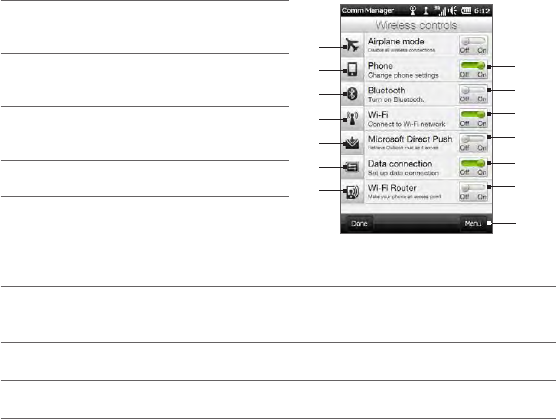
Chapter 14 Managing Your Phone 269
14.4 Using Comm Manager
Comm Manager lets you easily turn on and off the communication
features such as the phone connection, Bluetooth, Wi-Fi, and data
connection.
On the Home screen, slide to the Settings tab and then tap Wireless
controls to access Comm Manager.
1
Switch Airplane mode on or off.
(See “Turning the Phone Connection
On and Off” in Chapter 2.)
6
5
4
3
2
1
7
10
13
12
11
9
8
14
2
Access the phone settings and
change the PIN codes, configure
phone services, and more.
3
Connect a Bluetooth headset or
other Bluetooth-enabled device.
(See Chapter 10 for details.)
4
Connect to a wireless network.
(See Chapter 9 for details.)
5
Open ActiveSync to change
advanced sync settings that are not
available on the Data Services screen
(that’s opened from the Home
screen’s Settings tab).
6
Open Connection Setup to choose another country or mobile operator to
use for your data connection. (See “Using Connection Setup” in this chapter
for details.)
7
Set up your phone as a wireless router for your computer. (See “Using Your
Phone as a Wireless Router” in Chapter 9 for details.)
8
Switch the phone connection on or off. (See “Turning the Phone
Connection On and Off” in Chapter 2 for details.)

270 Chapter 14 Managing Your Phone
9
Switch Bluetooth on or off. (See Chapter 10 for details.)
10
Switch Wi-Fi on or off. (For more information about connecting to Wi-Fi
networks, see “Wi-Fi” in Chapter 9.)
11
Switch between automatically receiving (as items arrive) or manually
retrieving Outlook email messages. (See “Working With Company Email
Messages” in Chapter 8 for details.)
12
Connect or disconnect the active data connection (3G/GPRS, or EDGE).
13
Turn Wi-Fi Router on or off. (See “Using Your Phone as a Wireless Router”
in Chapter 9 for details.)
14
Tap Menu when you need to access and change the following settings:
Connections Set up one or more types of modem connection for your
phone, such as phone dial-up and GPRS, so that your phone can connect
to the Internet or a private local network. (See Chapter 9 for details.)
Domain Enroll Enroll your phone in your company’s domain to let System
Center Mobile Device Manager manage the phone. Ask your network
administrator for more details.
USB to PC Set the type of USB connection to your PC. Select the
ActiveSync option for synchronizing data, Disk Drive mode for transferring
files, or Internet Sharing to use your phone as a modem for your
computer.
•
•
•

Chapter 14 Managing Your Phone 271
14.5 Using Connection Setup
Connection Setup configures the phone’s data connection settings
for you based on the information on your SIM card or your selected
mobile operator.
Selecting another mobile operator
You can manually select your network operator and allow Connection
Setup to reconfigure your phone’s data connections settings based on
the selected operator.
1. On the Home screen, slide to the Settings tab and then tap
Wireless controls.
2. On the Comm Manager screen, tap Data connection.
3. Select the network Country and Operator you want to use, then
tap OK.
If you choose a country and/or operator that is different from
the installed SIM card network operator, you may not be able to
access network services.
4. When prompted to confirm whether you want to configure the
data connection settings, tap Yes.
5. After Connection Setup completes the configuration, tap Done.
Updating the Connection Setup database
Connection Setup has a built-in database containing various mobile
operator settings from which it retrieves data connection settings.
To check if there’s any new database update and download it to your
phone, tap Menu > Update Database and then tap Update Database.
This may incur additional data charges.

272 Chapter 14 Managing Your Phone
14.6 Using Task Manager
Task Manager shows which programs and processes are currently
running on your phone.
When you leave a program, such as by pressing the HOME, START
or BACK button, the program still runs in the background. Use Task
Manager to switch between programs or stop running programs.
1. Tap the title bar to open the Notifications screen.
2. Tap on the right side of the Task Manager item.
3. To switch to a running program, tap the program name and then
tap Menu > Switch To.
4. To stop running a program, tap the program name and then tap
End Task.
5. To stop running all programs, tap Menu > End All Tasks.
6. Tap Menu > Exit to close and stop running Task Manager.
14.7 Protecting Your Phone
Protecting your SIM card with a PIN
You can protect your SIM card by requiring a PIN (personal
identification number) every time the phone is turned on. You will not
be able to use the Phone dialer or the data connection until you enter
the correct PIN.
To enable the SIM card PIN
1. On the Home screen, slide to the Settings tab and then tap
Wireless controls.
2. On the Comm Manager screen, tap Phone to open the Phone
Settings screen.

Chapter 14 Managing Your Phone 273
3. Tap the PIN code Off/On switch.
4. Enter the PIN, tap OK, and then tap OK on the message box.
To change the PIN, tap Change PIN on the Phone Settings screen.
Emergency calls can be placed at any time, without requiring a PIN.
•
•
Protecting your phone with a password
You can help keep your data more secure by requiring a password
every time the phone is turned on.
To set a password
1. On the Home screen, slide to the Settings tab and then tap
Security > Phone lock.
2. Select the Prompt if phone unused for check box, and then
specify the idle time before the phone requires a password. If you
choose 0 Minutes, you will need to input the password every time
you wake the phone up from Sleep mode. For more information,
see “Switching to Sleep mode” in Chapter 1.
3. In the Password type box, select the type of password you would
like to use.
If your phone is configured to connect to a network, use an
alphanumeric password for increased security.
4. Enter the password in both the Password and Confirm boxes.
5. Tap Done.
If your phone is idle for the timeout period that you set, you will need
to enter your password to unlock your phone. If you used a simple
PIN password, the Lock screen will be displayed before you enter your
password. For information, see “Lock Screen” in Chapter 1.

274 Chapter 14 Managing Your Phone
To ensure that you can always make emergency calls, do not begin
your password with the digits of your local emergency number.
If you entered a hint, the hint will be displayed after the wrong
password is entered five times.
If you forget your password, you can hard reset or clear the phone’s
memory. For more information about hard resetting the phone and
clearing the memory, see “Resetting Your Phone”.
•
•
•
Encrypting files on your storage card
You can set your phone to encrypt files as they are saved on the
storage card.
1. On the Home screen, slide to the Settings tab and then tap
Security > Encryption.
2. Select Encrypt files when placed on a storage card.
Encrypted files can only be read on the phone that encrypted them.
Encrypted files are opened just like other files, provided you are
using the phone that encrypted them. There is no separate step for
you to take to read these files.
•
•
If Encrypt files when placed on a storage card is enabled, back up all
files from the storage card before performing a factory reset (Clear
Storage or hard reset) or updating the operating system. Otherwise,
you will no longer be able to access the encrypted files on the storage
card. Use ActiveSync or Windows Mobile Device Center to transfer
files between your storage card and computer. After the procedure,
copy your files back to the storage card.

Chapter 14 Managing Your Phone 275
14.8 Resetting Your Phone
If you are having a system problem with your phone, you can
perform a factory reset. After a factory reset, the phone is restored
to its default settings—the way it was when you first purchased
it and turned it on. You will lose any programs you installed, data
you entered, and settings you customized on your phone, and only
Windows Mobile software and other pre-installed programs will
remain.
There are two ways to do a factory reset. One way is to perform a
clear storage process through the phone settings. The other way is
to perform a hard reset by pressing certain buttons on your phone,
in cases when you are unable to start up your phone and enter the
phone settings.
Your phone will be set back to factory default settings. Make sure that
any additional installed programs and important data on your phone have
been backed up before you perform a factory reset.
If Encrypt files when placed on a storage card is enabled, back up all
files from the storage card before performing a factory reset (Clear
Storage or hard reset) or updating the operating system. Otherwise,
you will no longer be able to access the encrypted files on the storage
card. Use ActiveSync or Windows Mobile Device Center to transfer
files between your storage card and computer. After the procedure,
copy your files back to the storage card.
To perform a clear storage
1. On the Home screen, slide to the Settings tab and then tap
Security > Factory reset.
2. Enter “1234” and then tap Yes.
276 Chapter 14 Managing Your Phone
To perform a hard reset
1. With the phone turned off, press and hold the VOLUME UP and
VOLUME DOWN buttons, then press the POWER button shortly
and release it. You will then see a message on the screen warning
you that the operation will delete all your personal data and reset
all settings to manufacturer defaults.
2. Release the VOLUME UP and VOLUME DOWN buttons.
3. Press the VOLUME UP button to perform the hard reset, or press
any other button to cancel the reset.

Appendix
Specifications
CPU speed 600 MHz
Operating system Windows Mobile® 6.5 Professional with HTC Sense™
Memory ROM : 512 MB
RAM : 384 MB
•
•
Dimensions
(LxWxT)
103.8 X 57.7 X 11.7 mm (4.09 X 2.27 X 0.46 inches)
Weight 110 grams (3.88 ounces) with battery
Display 3.2-inch TFT-LCD touch-sensituve screen with
320 X 480 HVGA resolution
Network HSPA/WCDMA:
Europe/Asia: 900/2100 MHz
Upload speed of up to 2 Mbps and download speed of
up to 7.2 Mbps
Quad-band GSM/GPRS/EDGE:
850/900/1800/1900 MHz
(Band frequency, HSPA availability, and data speed are
operator dependent.)
•
•
•
GPS Internal GPS antenna
Sensors Proximity sensor
Ambient light sensor
G-Sensor
•
•
•
Connectivity Bluetooth® 2.1 with Enhanced Data Rate and A2DP for
stereo wireless headsets
Wi-Fi®: IEEE 802.11 b/g
3.5 mm stereo audio jack
Standard micro-USB (5-pin micro-USB 2.0)
•
•
•
•

278 Appendix
Camera 5 megapixel color camera with auto focus
Audio supported
formats
.aac, .amr, .m4a, .mid, .mp3, .mp4, .qcp, .wav, .wma
Video supported
formats
.wmv, .asf, .mp4, .3gp, .3g2, .m4v, .avi
Battery Rechargeable Lithium-ion polymer or Lithium-ion
battery
Capacity: 1200 mAh
Talk time: Up to 400 minutes for WCDMA
Up to 435 minutes for GSM
Standby time: Up to 500 hours for WCDMA
Up to 340 hours for GSM
(The above are subject to network and phone usage.)
•
•
•
•
Expansion slot microSD™ memory card (SD 2.0 compatible)
AC adapter Voltage range/frequency: 100 - 240V AC, 50/60 Hz
DC output: 5V and 1A
Specifications are subject to change without prior notice.

Index
A
A2DP 202
ActiveSync
- ActiveSync mode 43
- set up 120
- sync settings 259
- sync with computer 121
- sync with Exchange Server 152
Add and remove programs 254
Add contacts to your phone 93
Add quick links to Home screen 67
Airplane mode 59, 269
Alarm clock 66
Albums 231
Answer calls 49
Application (Settings tab) 261
Appointment 76
Attachment
- add to email 144
- download 145
Audio Booster 240
B
Back cover
- remove 24
- replace 26
Backlight 266
Basic settings 264
Battery
- battery time 278
- charge battery 27
- insert 25
Bing 222
Bluetooth
- car kit phones 207
- hands-free headset 202
- modem 193
- modes 198
- partnership (pairing) 200
- print 206
- send and receive information 203
- SIM Access Profile (SAP) 207
- stereo headset 202
- sync 123
- turn on and o 270
- visible 198
Brightness 266
C
Calculator 244
Calendar tab (Home screen) 76
Call
- emergency call 47
- from calendar reminders 46, 162
- from email message 46, 147
- from People tab (Home screen) 96
- from Phone dialer 45
- from text message 46, 141
- international call 47
280 Index
Call History 53
Camera 223
Car kit phones 207
Certificates 260
Clear storage 260, 275
Comm Manager 269
Compact QWERTY 107
Company Directory 163
Conference call 55, 158
Connections
- 3G/GPRS/EDGE and dial-up 270
Connection Setup 269, 271
Connect phone to Internet
- dial-up 168
- GPRS/3G 168
- Wi-Fi 165
Contact groups 101
Contacts 93, 97
Contacts Picture capture mode 224
Copy
- copy and manage files 256
- media files from PC to phone 237
Create new contacts 93
Customer feedback 262
D
Data connection 168, 169
Data services (Settings tab) 259
Date & time (Settings tab) 261
Dial-up 168
Directional pad (onscreen) 108
Direct Push 153, 270
Disconnect data connection 270
Disk Drive mode 43
Domain Enroll 270
Download
- download complete email 145
- email download settings 149
- file attachments 145
- Java applications 252
- location data 209
- sync email 148
Download satellites 260
E
Email
- email settings 149
- Internet email account (POP3/
IMAP4) 142
- Mail tab (Home screen) 70
- Outlook 152
- settings 260
- sync 116, 148, 152
Emergency call 47
Encryption 260
Ending calls 49
Enter text 106
Error reporting 262
Excel Mobile 246
Exchange Server 152
Exit programs 272
F
Facebook 189, 191
Facebook updates and events 102
Factory reset 260
Favorite contacts 68, 95
File Explorer 257
Find contact
- Company Directory 163
Finger gestures 40
Index 281
Finger panning 41
Finger scrolling 40
FM Radio 241
Footprints 211
Footprints tab (Home screen) 88
Forward email 144
Full QWERTY 107
G
G-Sensor 259
Google Maps 217
GPS 208
H
Hard reset 276
Home dialing 47
Home screen 32, 60
Home tab (Home screen) 62
I
Input
- enter text 109
- onscreen keyboard 106
Install and uninstall programs 254
International call
- home dialing (auto prepend country
code) 47
- plus code dialing 47
Internet 165
Internet email 142
Internet Explorer Mobile 174
Internet Sharing 43, 192
Internet tab (Home screen) 74
J
JBlend
- install MIDlets/MIDlet suites from
Internet 252
- install MIDlets/MIDlet suites from
phone 253
K
Keyboard languages 114
L
Library
- Music tab (Home screen) 83
- Windows Media Player Mobile 236
Live Messenger 182
Location (Settings tab) 260
Location Service 260
Lock screen 37
M
Mail tab (Home screen) 70
Managed programs 261
Meeting requests 160
Memory 277
Message conversations (threads) 133
Messages tab (Home screen) 69
Messenger 182
microSD card
- encrypt 274
- install 26
- store attachments 151
Microsoft My Phone 125
Microsoft Office Mobile 246
MMS Video capture mode 224
282 Index
Modem
- Bluetooth 193
- USB 192
MP3 Trimmer 243
Multimedia 223
Multimedia messages (MMS) 69, 100, 129,
132, 133
Music tab (Home screen) 82
Mute microphone 52
Mute ring 49
My Contact Card 91
My Phone 125
N
Navigation pad (onscreen) 108
Notifications 35, 38
Notification sounds 266
O
Office Mobile 246
OneNote Mobile 246
Onscreen keyboard
- Compact QWERTY 107
- Full QWERTY 107
- Phone Keypad 107
Opera Mobile 170
Other (Settings tab) 262
P
Panorama capture mode 224
Password 260, 273
People tab (Home screen) 68, 90
Personalize (Settings tab)
- Font 258
- Home screen tabs 258
- Home tab wallpaper 258
- Lock screen wallpaper 258
- Vibration 258
Phone Keypad 107
Phone lock 260, 273
Phone name 267
Phone services 268
Photo capture mode 224
Photos & Videos tab (Home screen) 81
PIN 272
Pinch zooming 41
Playlists
- Music tab (Home screen) 84
- Windows Media Player Mobile 239
Play music
- Music tab (Home screen) 82
- Windows Media Player Mobile 236
Play video
- Albums 234
- Windows Media Player Mobile 236
Pocket mode 50
Power
- turn o 31
- turn on 28
PowerPoint Mobile 246
Predictive mode 110
Profile 259, 264
Q
Quick links 67
Quiet ring on pickup 50
R
Regional settings 261
Remove programs 255, 261
Remove quick links from the Home
screen 67
Index 283
Reply
- email 144
- multimedia message (MMS) 134
- text message (SMS) 134
Reset phone 275
Resolution (camera) 225
Ring tone 265
Ring type 265
S
SD card & phone storage (Settings
tab) 261
Security (Settings tab) 260
Send
- email 143
- multimedia message (MMS) 129
- text message (SMS) 128
Settings 258
Settings tab (Home screen) 89
Set up phone for the first time 28
Share photos and videos from
Albums 235
Shortcuts 67
SIM Access Profile (SAP) 207
SIM card
- insert 25
- PIN 272
SIM Manager 251
Sleep mode 30, 266
Smart Dial 45
SMS 69, 128, 132
Social networking 165, 260
Sound & Display (Settings tab) 259
Speakerphone 51, 57
Specifications 277
Speed Dial 54
Start screen 36
Status icons 33
Stocks tab (Home screen) 79
Stop running programs 272
Storage card
- encrypt 274
- store attachments 151
Streaming Media 180
Sync
- ActiveSync 121
- change information types 122
- Microsoft My Phone 125
- music and videos 124
- via Bluetooth 123
- Windows Media Player 237
- Windows Mobile Device Center 118
- with computer 121
- with Exchange Server 152
T
Task Manager 272
Text entry 106
Text input settings 115, 261
Text messages (SMS) 100, 128, 132, 133
Troubleshoot
- sync connection 123
- Windows Media Player Mobile 239
Turn phone connection on and off 59,
269
Turn power off 31
Turn power on 28
Twitter tab (Home screen) 88, 184
Type text 106
284 Index
U
Uninstall programs 254
Updates & feedback (Settings tab) 262
Updates and events (Facebook) 102
Uploader 262
USB modem 192
USB to PC 123, 262, 270
V
Vibrate 39
Video capture mode 224
View photos and videos using
Albums 231
Voice call 44
Voicemail 46
Voice Recorder 249
Volume 39, 259, 265
W
Wallpaper 63
Weather tab (Home screen) 86
Wi-Fi 165, 262, 270
Wi-Fi Router 195, 270
Windows Live 181
Windows Live Messenger 182
Windows Media Player Mobile 236
Windows Mobile Device Center 118
Wireless controls (Settings tab) 258
Wireless network 165, 269
Word Mobile 246
WorldCard Mobile 248
World Clock 64
X
XT9 predictive mode 110
Y
YouTube 177, 190
Z
Zooming
- Camera 224
- Internet Explorer Mobile 176
- Opera Mobile 172